Paul van Yperen's Blog, page 410
August 13, 2014
Rex Gildo
German Schlager singer and actor Rex Gildo (1936-1999) was a teen idol in the 1960s and 1970s. The German Cliff Richard showed durability. In a career of 40 years, he sold around 39 million records and starred in more than 30 films.
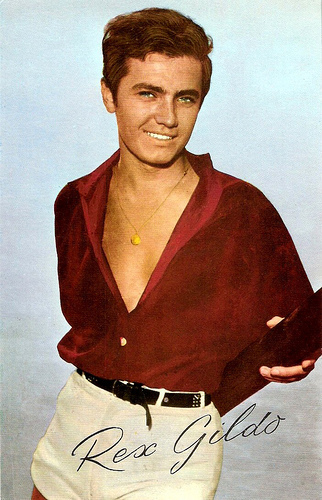 Dutch postcard.
Dutch postcard.
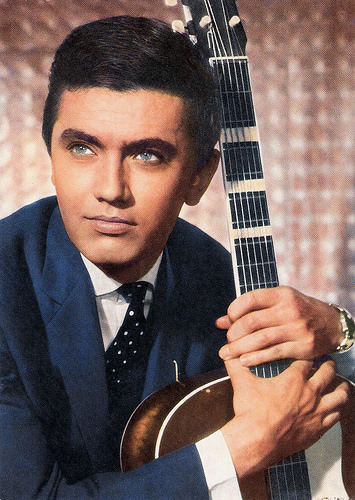
Dutch postcard by Gebr. Spanjersberg N.V., Rotterdam, no. CK 352. Photo: Ufa.
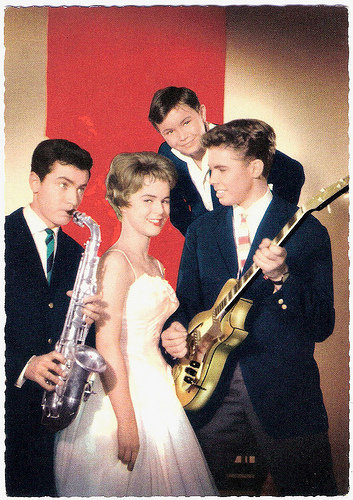
German postcard by ISV, no. E 13. Photo: Constantin / Grimm. With Conny Froboess, Peter Kraus and Rolf Pinegger.
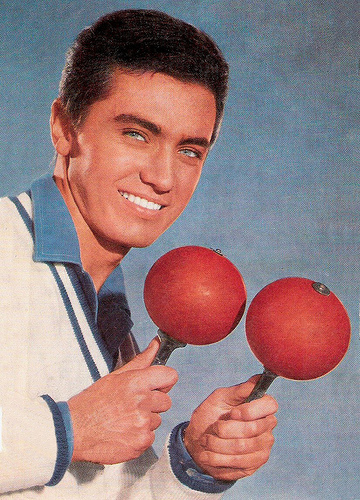 Dutch postcard by Gebr. Spanjersberg N.V., Rotterdam, nr. CK 370. Photo: Ufa.
Dutch postcard by Gebr. Spanjersberg N.V., Rotterdam, nr. CK 370. Photo: Ufa.
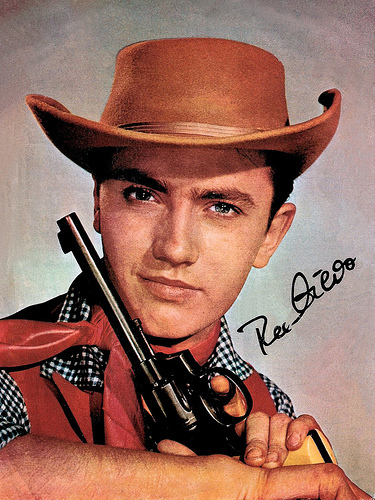 Big Dutch postcard.
Big Dutch postcard.
Sexy Rexy
Rex Gildo was born as Ludwig Franz Hirtreiter in Straubing, Bavaria, in 1936.
He later claimed to have been a member of the Regensburger Domspatzen choir before attending acting lessons at the Otto-Falckenburg-Schule in Munich.
The German TV documentary series Legenden/Legends (Ulrike Bremer, 2009) revealed that in fact he had worked in a decorating apprenticeship before he met Fred Miekley, who would become his manager and longtime companion and presumably paid for Gildo's acting, dancing and singing lessons.
However, Ludwig made his stage debut as Alexander Gildo with the Munich Kammerspiele theatre group in 1956, but he quickly moved on to TV and to the cinema.
Ada Tschechowa, manager of the Munich Kammerspiele, introduced him for his film début in Immer wenn der Tag beginnt/Whenever the Day Starts (Wolfgang Liebeneiner, 1957) opposite Ruth Leuwerik and Hans Söhnker .
In 1958 he already played his first leading part opposite teen idols Conny Froboess in the film Hula-Hopp, Conny/Hula Hoop, Conny (Heinz Paul, 1959).
In 1959, his future record producer Nils Nobach, offered him a contract at record label Electrola and gave him the stage name Rex Gildo, recordedly inspired by the phrase 'sexy Rexy'.
In the following years Gildo sang and played in such forgettable Schlagerfilms as Ja, so ein Mädchen mit sechzehn/Yes, Such a Girl of Sixteen (Hans Grimm, 1959) again with Conny Froboess, Meine Nichte tut das nicht/My Niece Doesn't Do That (Franz Josef Gottlieb, 1960), Marina (Paul Martin, 1960), Schlagerparade (Franz Marischka, 1960) with Vivi Bach , Zwei blaue Vergissmeinnicht/Carnation Frank (Helmut M. Backhaus, 1963), and Apartmentzauber/Apartment Magic (Helmut M. Backhaus, 1963) with Helga Sommerfeld .
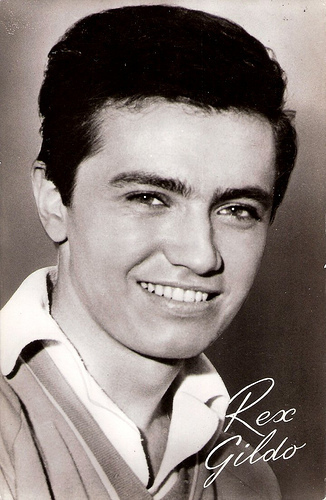 Dutch postcard by Takken, Utrecht, no. AX 4730.
Dutch postcard by Takken, Utrecht, no. AX 4730.
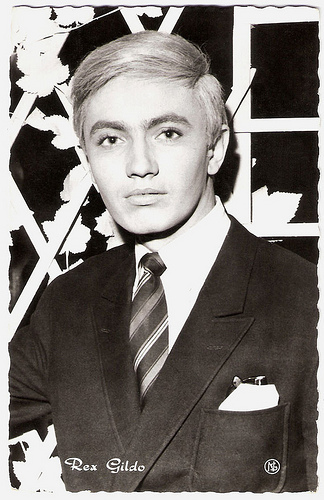
Dutch postcard by NS, no. 34.
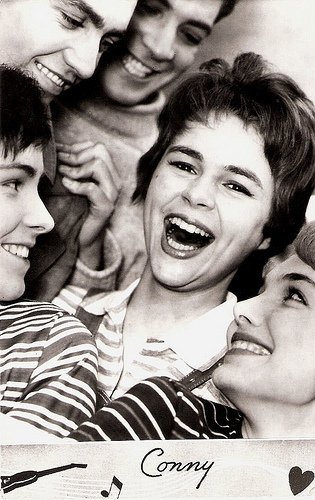
Vintage card, with Conny Froboess and at far left Rex Gildo.
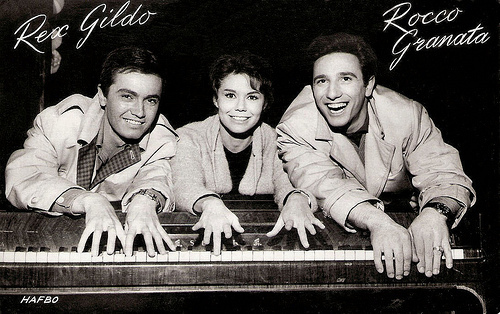
Dutch postcard by Uitg. Takken, Utrecht, no. AX 4687. Photo: Hafbo. Publicity still for the Schlagerfilm Marina (Paul Martin, 1960), which was distributed in Holland as Teenagers Schlager Parade. The girl between Rex Gildo and Rocco Granata is the female lead of the film, Italian actress Giorgia Moll .
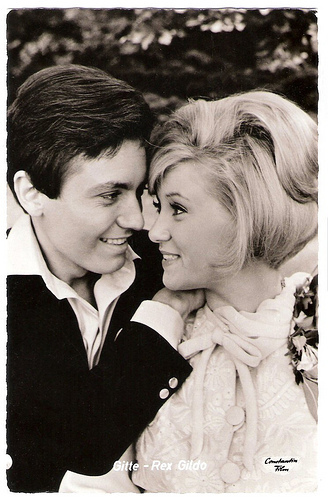 German postcard by Friedrich-W. Sander-Verlag, Minden/Westf. in the Kolibri series. Photo: Wiener Stadthalle/Constantin. Publicity still for Jezt dreht die Welt sich nur um dich/The World Turns Just Around You Now (1964) with
Gitte
.
German postcard by Friedrich-W. Sander-Verlag, Minden/Westf. in the Kolibri series. Photo: Wiener Stadthalle/Constantin. Publicity still for Jezt dreht die Welt sich nur um dich/The World Turns Just Around You Now (1964) with
Gitte
.
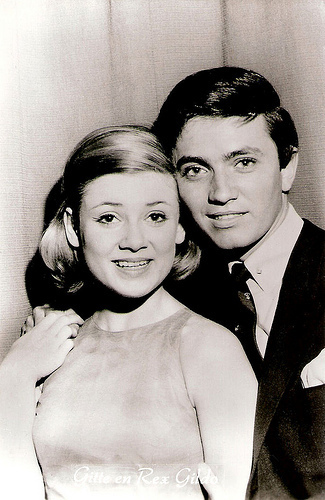
Dutch postcard by SYBA, no. 36 with Gitte .
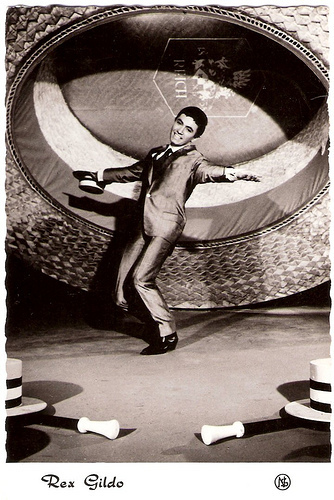 Dutch postcard by NSO. Sent by mail in 1963.
Dutch postcard by NSO. Sent by mail in 1963.
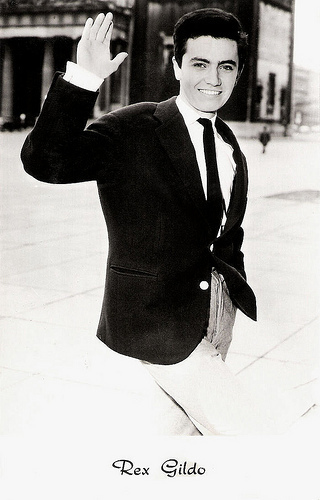
Dutch postcard by Gebr. Spanjersberg N.V., Rotterdam, no. 5955.
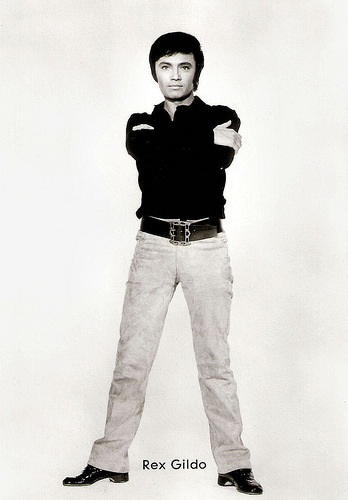
German postcard by Franz Josef Rüdel, Hamburg, no. 5191. Photo: publicity still for Was ist den bloss - mit Willi los?/What Is the Matter with Willi? (Werner Jacobs, 1970).
Fernweh
Early 1960, Rex Gildo had his first hit song with Sieben Wochen nach Bombay/Seven Weeks to Bombay, which reached to #13 in the German charts.
Rex's schlagers would become million sellers in Germany, but less so abroad. His hits, such as Speedy Gonzales (1962), Goodbye Susanna (1965), and Fiesta Mexicana (1972) were sentimental, ‘fernweh’ (wanderlust) evoking music, often flavoured with Spanish or Mexican elements.
In 1962, he formed the very popular duo Gitte & Rex with Danish singer Gitte Hænning .
Together they starred in the musical Jetzt dreht die Welt sich nur um dich/The World Turns Just Around You Now (Wolfgang Liebeneiner. 1964).
The two were rumoured to be engaged to be married. Later Gitte recalled that it was just a publicity stunt by the record company, and she was so sore about it that she broke off the collaboration with Gildo.
Rex later had his own TV show, Gestatten - Rex Gildo/May I - Rex Gildo.
During the 1980s and 1990s, his popularity decreased and he felt pressured to maintain his public image. Reportedly he became a tragic figure who desperately tried to mask his age with wigs and a lot of make-up.
He died in 1999 aged 63, having spent three days in an artificially-induced coma after attempting suicide.
Although he married his cousin Marion Hirtreiter in 1974, after his death it was reported that he had been gay. Rex Gildo was buried next to his former longtime companion Fred Miekley.
His life was the subject of the beautiful Dutch documentary Rex Gildo - De val van een schlagerkoning/Rex Gildo - The Fall of a Schlager King (Hans Heijnen, 2003).
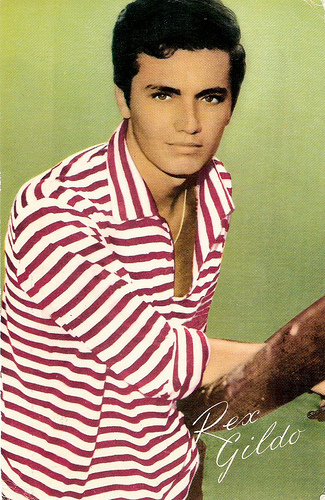
Dutch postcard, ca. 1961.
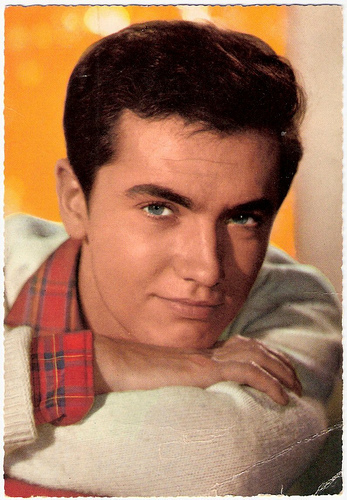 German postcard by ISV, no. E 15. Photo: Constantin/Grimm.
German postcard by ISV, no. E 15. Photo: Constantin/Grimm.
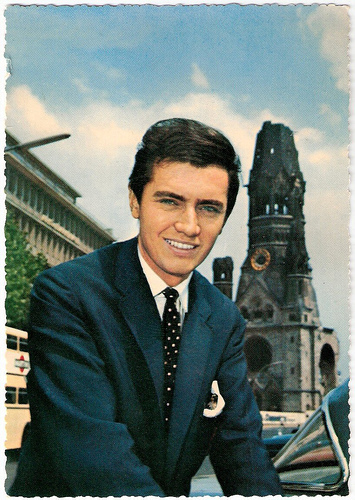 German postcard by Electrola, no. 902/70. Photo: Schneider, München.
German postcard by Electrola, no. 902/70. Photo: Schneider, München.
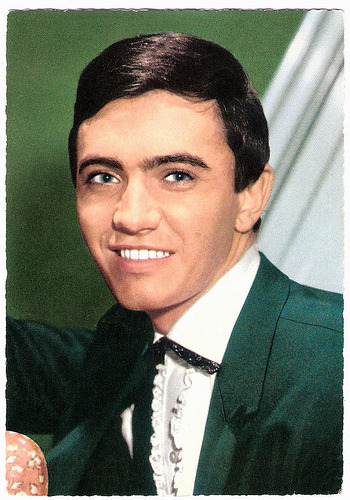
German postcard by ISV, no. K 13.
Rex Gildo sings the title song of Zwei blaue Vergissmeinnicht/Carnation Frank (1963). Source: fritz51203 (YouTube).
Rex Gildo and Gitte Hænning sing Der Hokuspokus in Jetzt dreht die Welt sich nur um dich (1964). Source: rexgildofan (YouTube).
Sources: Stephanie D'Heil (Steffi-line), Wikipedia and .
 Dutch postcard.
Dutch postcard.
Dutch postcard by Gebr. Spanjersberg N.V., Rotterdam, no. CK 352. Photo: Ufa.

German postcard by ISV, no. E 13. Photo: Constantin / Grimm. With Conny Froboess, Peter Kraus and Rolf Pinegger.
 Dutch postcard by Gebr. Spanjersberg N.V., Rotterdam, nr. CK 370. Photo: Ufa.
Dutch postcard by Gebr. Spanjersberg N.V., Rotterdam, nr. CK 370. Photo: Ufa. Big Dutch postcard.
Big Dutch postcard.Sexy Rexy
Rex Gildo was born as Ludwig Franz Hirtreiter in Straubing, Bavaria, in 1936.
He later claimed to have been a member of the Regensburger Domspatzen choir before attending acting lessons at the Otto-Falckenburg-Schule in Munich.
The German TV documentary series Legenden/Legends (Ulrike Bremer, 2009) revealed that in fact he had worked in a decorating apprenticeship before he met Fred Miekley, who would become his manager and longtime companion and presumably paid for Gildo's acting, dancing and singing lessons.
However, Ludwig made his stage debut as Alexander Gildo with the Munich Kammerspiele theatre group in 1956, but he quickly moved on to TV and to the cinema.
Ada Tschechowa, manager of the Munich Kammerspiele, introduced him for his film début in Immer wenn der Tag beginnt/Whenever the Day Starts (Wolfgang Liebeneiner, 1957) opposite Ruth Leuwerik and Hans Söhnker .
In 1958 he already played his first leading part opposite teen idols Conny Froboess in the film Hula-Hopp, Conny/Hula Hoop, Conny (Heinz Paul, 1959).
In 1959, his future record producer Nils Nobach, offered him a contract at record label Electrola and gave him the stage name Rex Gildo, recordedly inspired by the phrase 'sexy Rexy'.
In the following years Gildo sang and played in such forgettable Schlagerfilms as Ja, so ein Mädchen mit sechzehn/Yes, Such a Girl of Sixteen (Hans Grimm, 1959) again with Conny Froboess, Meine Nichte tut das nicht/My Niece Doesn't Do That (Franz Josef Gottlieb, 1960), Marina (Paul Martin, 1960), Schlagerparade (Franz Marischka, 1960) with Vivi Bach , Zwei blaue Vergissmeinnicht/Carnation Frank (Helmut M. Backhaus, 1963), and Apartmentzauber/Apartment Magic (Helmut M. Backhaus, 1963) with Helga Sommerfeld .
 Dutch postcard by Takken, Utrecht, no. AX 4730.
Dutch postcard by Takken, Utrecht, no. AX 4730.
Dutch postcard by NS, no. 34.

Vintage card, with Conny Froboess and at far left Rex Gildo.

Dutch postcard by Uitg. Takken, Utrecht, no. AX 4687. Photo: Hafbo. Publicity still for the Schlagerfilm Marina (Paul Martin, 1960), which was distributed in Holland as Teenagers Schlager Parade. The girl between Rex Gildo and Rocco Granata is the female lead of the film, Italian actress Giorgia Moll .
 German postcard by Friedrich-W. Sander-Verlag, Minden/Westf. in the Kolibri series. Photo: Wiener Stadthalle/Constantin. Publicity still for Jezt dreht die Welt sich nur um dich/The World Turns Just Around You Now (1964) with
Gitte
.
German postcard by Friedrich-W. Sander-Verlag, Minden/Westf. in the Kolibri series. Photo: Wiener Stadthalle/Constantin. Publicity still for Jezt dreht die Welt sich nur um dich/The World Turns Just Around You Now (1964) with
Gitte
.
Dutch postcard by SYBA, no. 36 with Gitte .
 Dutch postcard by NSO. Sent by mail in 1963.
Dutch postcard by NSO. Sent by mail in 1963.
Dutch postcard by Gebr. Spanjersberg N.V., Rotterdam, no. 5955.

German postcard by Franz Josef Rüdel, Hamburg, no. 5191. Photo: publicity still for Was ist den bloss - mit Willi los?/What Is the Matter with Willi? (Werner Jacobs, 1970).
Fernweh
Early 1960, Rex Gildo had his first hit song with Sieben Wochen nach Bombay/Seven Weeks to Bombay, which reached to #13 in the German charts.
Rex's schlagers would become million sellers in Germany, but less so abroad. His hits, such as Speedy Gonzales (1962), Goodbye Susanna (1965), and Fiesta Mexicana (1972) were sentimental, ‘fernweh’ (wanderlust) evoking music, often flavoured with Spanish or Mexican elements.
In 1962, he formed the very popular duo Gitte & Rex with Danish singer Gitte Hænning .
Together they starred in the musical Jetzt dreht die Welt sich nur um dich/The World Turns Just Around You Now (Wolfgang Liebeneiner. 1964).
The two were rumoured to be engaged to be married. Later Gitte recalled that it was just a publicity stunt by the record company, and she was so sore about it that she broke off the collaboration with Gildo.
Rex later had his own TV show, Gestatten - Rex Gildo/May I - Rex Gildo.
During the 1980s and 1990s, his popularity decreased and he felt pressured to maintain his public image. Reportedly he became a tragic figure who desperately tried to mask his age with wigs and a lot of make-up.
He died in 1999 aged 63, having spent three days in an artificially-induced coma after attempting suicide.
Although he married his cousin Marion Hirtreiter in 1974, after his death it was reported that he had been gay. Rex Gildo was buried next to his former longtime companion Fred Miekley.
His life was the subject of the beautiful Dutch documentary Rex Gildo - De val van een schlagerkoning/Rex Gildo - The Fall of a Schlager King (Hans Heijnen, 2003).

Dutch postcard, ca. 1961.
 German postcard by ISV, no. E 15. Photo: Constantin/Grimm.
German postcard by ISV, no. E 15. Photo: Constantin/Grimm. German postcard by Electrola, no. 902/70. Photo: Schneider, München.
German postcard by Electrola, no. 902/70. Photo: Schneider, München.
German postcard by ISV, no. K 13.
Rex Gildo sings the title song of Zwei blaue Vergissmeinnicht/Carnation Frank (1963). Source: fritz51203 (YouTube).
Rex Gildo and Gitte Hænning sing Der Hokuspokus in Jetzt dreht die Welt sich nur um dich (1964). Source: rexgildofan (YouTube).
Sources: Stephanie D'Heil (Steffi-line), Wikipedia and .
Published on August 13, 2014 23:00
August 12, 2014
Agnes Petersen
Agnes Petersen (1904-1953?) was a star of the Danish and German silent cinema. She was the second wife of the legendary Russian-born film star and charmer Ivan Mozzhukhin.
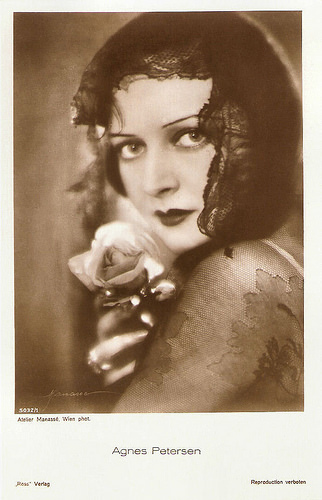
German postcard by Ross Verlag, no. 5032/1, 1930-1931. Photo: Atelier Manassé , Wien.
Dark-haired beauty
Agnes Petersen was born in 1904. Sometimes she was credited as Agnes Petersen-Mozzuchin or Agnes Peterson.
She was Danish, but unknown is where exactly the dark-haired beauty was born.
In 1924, she started her film career in the Danish comedies Raske Riviera Rejsende/Healthy Riviera Travelers (Lau Lauritzen, 1924) and Ole Opfinders offer/Inventor Ole’s Sacrifice (Lau Lauritzen, 1924), both starring the duo Harald Madsen and Carl Schenstrøm a.k.a. Fy og Bi or Long and Short.
For the Nordisk studio she appeared in the drama Den store Magt/The great power (August Blom, 1925) with Lili Beck .
The Danish film industry imploded and Harald Madsen and Carl Schenstrøm moved to Germany, where they were well-known as Pat und Patachon.
In their comedy Schwiegersöhne/Sons-in-law (Hans Steinhoff, 1926), Agnes Petersen also had a part.
In Germany, Petersen soon found more roles. In the drama Die Gefangene von Shanghai/The prisoner of Shanghai (Géza von Bolváry, Augusto Genina, 1927) she played the Chinese Li. The lead roles in this German production were played by Italian Carmen Boni and British Jack Trevor .
Other German films with Petersen were Dr. Bessels Verwandlung/Dr. Bessel‘s Transformation (Richard Oswald, 1927) with Hans Stüwe , Frauenarzt Dr. Schäfer/Gynaecologist Dr.Schäfer (Jacob and Luise Fleck, 1928) featuring Iván Petrovich .
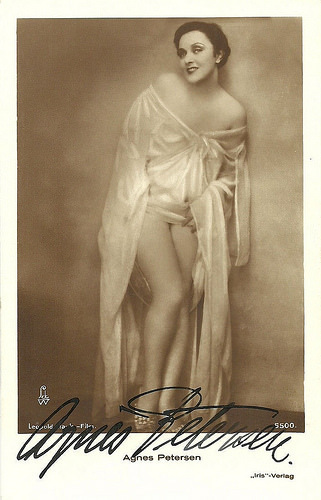
Austrian postcard by Iris-Verlag, no. 5500. Collection: Didier Hanson.
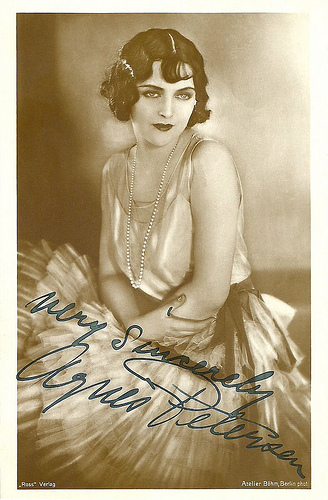
German postcard by Ross Verlag. Photo: Atelier Böhm, Berlin. Collection: Didier Hanson.
The Laughing Lady
In Berlin, Agnes Petersen met the famous Russian-born actor Ivan Mozzhukhin . They married and she started to use the name Agnes Petersen-Mozżuchinowa.
With her husband she travelled to Hollywood, but their American adventure was not a success. Soon they were back in Berlin
She appeared in the drama Geheimnisse des Orients/Secrets of the Orient (Alexandre Volkoff, 1928) again with Iván Petrovich and with Nicolas Koline .
In Der geheime Kurier/The Secret Courier (Gennaro Righelli, 1928), she co-starred with Lil Dagover and Mozzhukhin.
With the rise of the sound film she could no longer continue her film career in Germany. In Czechoslovakia she played the lead role in the drama Hrích/Sin (Carl Lamac, 1929) and in Poland in Kult ciala/The cult of the body (Michal Waszynski, 1930) with Victor Varconi .
Her last film was the Swedish production Den farliga leken (Gustaf Bergman, 1931) starring Jenny Hasselqvist. This Paramount production was an alternative language production of The Laughing Lady (Victor Schertzinger, 1929) and was shot at the Paramount studio in Joinville in France.
Little is known about her further life. In 1939 her husband Ivan Mozzhukin died from a severe form of tuberculosis. According to Poul at NitrateVille , Agnes Petersen also died from tuberculosis at the age of 49 (in 1953 or 1954?).
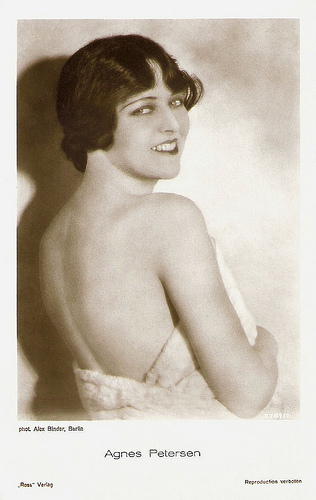
German postcard by Ross Verlag, no. 3761/1, 1928-1929. Photo: Alex Binder , Berlin.
Sources: Poul (NitrateVille), Thomas Staedeli (Cyranos), Wikipedia (Polish) and

German postcard by Ross Verlag, no. 5032/1, 1930-1931. Photo: Atelier Manassé , Wien.
Dark-haired beauty
Agnes Petersen was born in 1904. Sometimes she was credited as Agnes Petersen-Mozzuchin or Agnes Peterson.
She was Danish, but unknown is where exactly the dark-haired beauty was born.
In 1924, she started her film career in the Danish comedies Raske Riviera Rejsende/Healthy Riviera Travelers (Lau Lauritzen, 1924) and Ole Opfinders offer/Inventor Ole’s Sacrifice (Lau Lauritzen, 1924), both starring the duo Harald Madsen and Carl Schenstrøm a.k.a. Fy og Bi or Long and Short.
For the Nordisk studio she appeared in the drama Den store Magt/The great power (August Blom, 1925) with Lili Beck .
The Danish film industry imploded and Harald Madsen and Carl Schenstrøm moved to Germany, where they were well-known as Pat und Patachon.
In their comedy Schwiegersöhne/Sons-in-law (Hans Steinhoff, 1926), Agnes Petersen also had a part.
In Germany, Petersen soon found more roles. In the drama Die Gefangene von Shanghai/The prisoner of Shanghai (Géza von Bolváry, Augusto Genina, 1927) she played the Chinese Li. The lead roles in this German production were played by Italian Carmen Boni and British Jack Trevor .
Other German films with Petersen were Dr. Bessels Verwandlung/Dr. Bessel‘s Transformation (Richard Oswald, 1927) with Hans Stüwe , Frauenarzt Dr. Schäfer/Gynaecologist Dr.Schäfer (Jacob and Luise Fleck, 1928) featuring Iván Petrovich .

Austrian postcard by Iris-Verlag, no. 5500. Collection: Didier Hanson.

German postcard by Ross Verlag. Photo: Atelier Böhm, Berlin. Collection: Didier Hanson.
The Laughing Lady
In Berlin, Agnes Petersen met the famous Russian-born actor Ivan Mozzhukhin . They married and she started to use the name Agnes Petersen-Mozżuchinowa.
With her husband she travelled to Hollywood, but their American adventure was not a success. Soon they were back in Berlin
She appeared in the drama Geheimnisse des Orients/Secrets of the Orient (Alexandre Volkoff, 1928) again with Iván Petrovich and with Nicolas Koline .
In Der geheime Kurier/The Secret Courier (Gennaro Righelli, 1928), she co-starred with Lil Dagover and Mozzhukhin.
With the rise of the sound film she could no longer continue her film career in Germany. In Czechoslovakia she played the lead role in the drama Hrích/Sin (Carl Lamac, 1929) and in Poland in Kult ciala/The cult of the body (Michal Waszynski, 1930) with Victor Varconi .
Her last film was the Swedish production Den farliga leken (Gustaf Bergman, 1931) starring Jenny Hasselqvist. This Paramount production was an alternative language production of The Laughing Lady (Victor Schertzinger, 1929) and was shot at the Paramount studio in Joinville in France.
Little is known about her further life. In 1939 her husband Ivan Mozzhukin died from a severe form of tuberculosis. According to Poul at NitrateVille , Agnes Petersen also died from tuberculosis at the age of 49 (in 1953 or 1954?).

German postcard by Ross Verlag, no. 3761/1, 1928-1929. Photo: Alex Binder , Berlin.
Sources: Poul (NitrateVille), Thomas Staedeli (Cyranos), Wikipedia (Polish) and
Published on August 12, 2014 23:00
August 11, 2014
Patricia Medina
In the 1940s, voluptuous and exotic-looking British-born film star Patricia Medina (1919-2012) left for Hollywood. There she became a prolific star in melodrama’s and adventure films in the early 1950s. Most notable is her role in Orson Welles' Mr. Arkadin (1955).
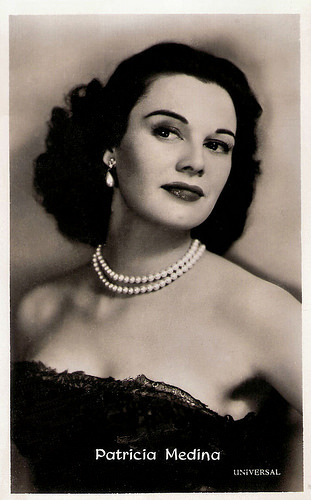
Belgian postcard offered by Nieuwe Merksemsche Chocolaterie S.P.R.L., Merksem (Anvers). Photo: Universal.
Darkly beautiful
Patricia Paz Maria Medina was born in Liverpool, England in 1919. The darkly beautiful Medina had a Spanish father, Ramón Medina Nebot from the Canary Islands. and an English mother.
She began acting as a teenager in the late 1930s in comedies as Simply Terrific (Roy William Neill 1938) with Claude Hulbert .
In 1941 she married actor Richard Greene . She continued to play supporting parts in films like the thriller Hotel Reserve (Lance Comfort, Mutz Greenbaum, Victor Hanbury, 1944) starring James Mason .
Her first starring part was in the romantic comedy Don't Take It to Heart (Jeffrey Dell, 1944) in which her husband Richard Greene was her co-star.
In 1946, she and Greene went to Hollywood, where he had to complete his contract with 20th Century-Fox. They bought a house in Coldwater Canyon (Beverly Hills) and rented a beach cottage in Malibu.
They appeared together in the swashbuckler The Fighting O'Flynn (Arthur Pierson, 1949) with Douglas Fairbanks jr., but in 1948 the pair separated and in 1951 they divorced.
Medina returned to England to star in the film Children of Chance (Luigi Zampa, 1949), an alternate language version of Campane a Martello/Church Bells (Luigi Zampa, 1949) with Gina Lollobrigida .
Back in Hollywood, she played a beautiful lady spy in the war comedy Francis (1949) with Donald O’Connor and 'Francis the Talking Mule'. It was the first film in a popular series.
Medina was also the leading lady of the farce Abbott and Costello in the Foreign Legion (Charles Lamont, 1950).
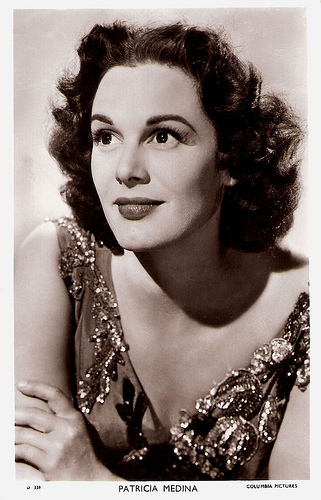
British postcard in the Picturegoer Series, London, no. D 338. Photo: Columbia Pictures.
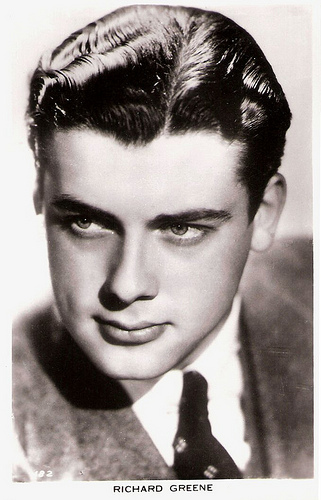
Richard Greene . British postcard by Real Photograph.
Assorted feisty love interests and damsels to rescue
Patricia Medina teamed up with British actor Louis Hayward and they appeared together in four adventure films: Fortunes of Captain Blood (Gordon Douglas, 1950), The Lady and the Bandit (Ralph Murphy, 1951), Lady in the Iron Mask (Ralph Murphy, 1952) and Captain Pirate (Ralph Murphy, 1952).
Medina was often typecast in adventure films like Plunder of the Sun (John Farrow, 1953) and period melodramas such as The Black Knight (Tay Garnett, 1954) starring Alan Ladd.
Her acting strength was hardly ever tested, stuck mostly in high-flying adventures as assorted feisty love interests and damsels to rescue.
Two of her more notable films were Stranger at My Door (William Witney, 1956) and Orson Welles ' crime drama Mr. Arkadin/Confidential Report (1955) with Welles and Michael Redgrave .
Mr Arkadin was a follow-up of The Third Man (Carol Reed, 1949) and was based on the radio series The Lives of Harry Lime.
In Italy, she starred in the adventure film Il mantello rosso/The Red Cloak (Giuseppe Maria Scotese, 1955) with Fausto Tozzi and Jean Murat .
On Television, Medina appeared as Margarita Cortazar in four episodes of Walt Disney's popular series Zorro (1957), and as Diana Coulter in two episodes of Richard Boone's Have Gun - Will Travel (1957).
Her film career faded away by the end of the decade.
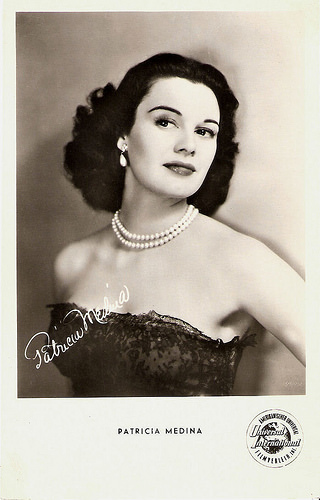
German postcard by Kunst und Bild, Berlin, no. A 272. Photo: Universal International.
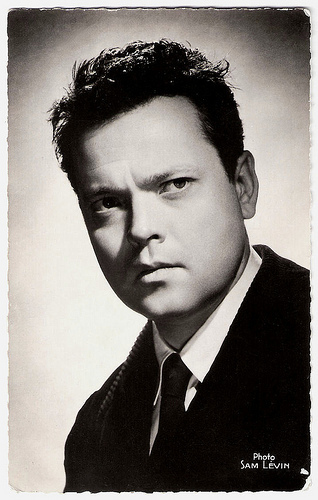
Orson Welles . French postcard by Editions du Globe, no. 143. Photo: Sam Lévin .
Personal friends with Mr. and Mrs. Ronald Reagan
Patricia Medina married American actor Joseph Cotten in 1960.
In 1962, she made her Broadway debut opposite Cotten in the murder mystery Calculated Risks.
Her appearances on television include episodes of Perry Mason (1957), Bonanza (1959), Rawhide (1961), The Alfred Hitchcock Hour (1962) and The Man from U.N.C.L.E. (1964).
She returned to the screen in Robert Aldrich's adaptation of the lesbian-themed drama The Killing of Sister George (1968) with Beryl Reid and Susannah York.
Medina appeared in a few more films, the Japanese-American Science-Fiction Ido zero daisakusen/Latitude Zero (Ishirô Honda, 1969) with Joseph Cotten, and the Mexican drama El llanto de los pobres/The cry of the poor (Rubén Galindo, 1978).
She and Joseph Cotten, also toured together in several plays.
Patricia Medina retired from acting in 1978 after 40 years in the motion picture industry. She had become a naturalized citizen of the United States. She and Cotten were both staunch Republicans and personal friends with Mr. and Mrs. Ronald Reagan.
In 1998, Medina published an autobiography, Laid Back in Hollywood: Remembering.
She died at age 92 of natural causes in 2012 in Los Angeles. She was interred at Blandford Cemetary in Petersburg beside her beloved Joseph Cotten, who had passed away in 1994. They had no children.
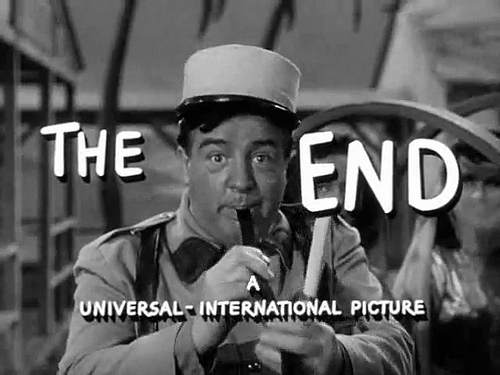
The End of Abbott and Costello in the Foreign Legion (Charles Lamont, 1950). Source: Leo Garcia (Flickr).
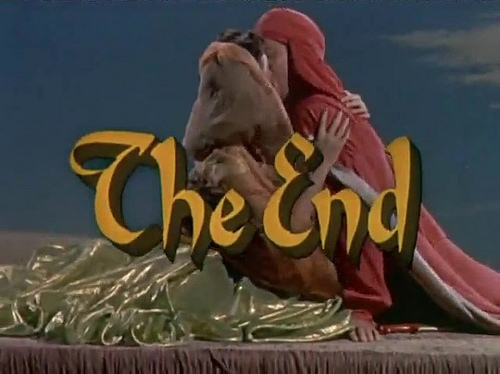
The End of The Magic Carpet (Lew Landers, 1951). Source: Leo Garcia (Flickr).
Sources:

Belgian postcard offered by Nieuwe Merksemsche Chocolaterie S.P.R.L., Merksem (Anvers). Photo: Universal.
Darkly beautiful
Patricia Paz Maria Medina was born in Liverpool, England in 1919. The darkly beautiful Medina had a Spanish father, Ramón Medina Nebot from the Canary Islands. and an English mother.
She began acting as a teenager in the late 1930s in comedies as Simply Terrific (Roy William Neill 1938) with Claude Hulbert .
In 1941 she married actor Richard Greene . She continued to play supporting parts in films like the thriller Hotel Reserve (Lance Comfort, Mutz Greenbaum, Victor Hanbury, 1944) starring James Mason .
Her first starring part was in the romantic comedy Don't Take It to Heart (Jeffrey Dell, 1944) in which her husband Richard Greene was her co-star.
In 1946, she and Greene went to Hollywood, where he had to complete his contract with 20th Century-Fox. They bought a house in Coldwater Canyon (Beverly Hills) and rented a beach cottage in Malibu.
They appeared together in the swashbuckler The Fighting O'Flynn (Arthur Pierson, 1949) with Douglas Fairbanks jr., but in 1948 the pair separated and in 1951 they divorced.
Medina returned to England to star in the film Children of Chance (Luigi Zampa, 1949), an alternate language version of Campane a Martello/Church Bells (Luigi Zampa, 1949) with Gina Lollobrigida .
Back in Hollywood, she played a beautiful lady spy in the war comedy Francis (1949) with Donald O’Connor and 'Francis the Talking Mule'. It was the first film in a popular series.
Medina was also the leading lady of the farce Abbott and Costello in the Foreign Legion (Charles Lamont, 1950).

British postcard in the Picturegoer Series, London, no. D 338. Photo: Columbia Pictures.

Richard Greene . British postcard by Real Photograph.
Assorted feisty love interests and damsels to rescue
Patricia Medina teamed up with British actor Louis Hayward and they appeared together in four adventure films: Fortunes of Captain Blood (Gordon Douglas, 1950), The Lady and the Bandit (Ralph Murphy, 1951), Lady in the Iron Mask (Ralph Murphy, 1952) and Captain Pirate (Ralph Murphy, 1952).
Medina was often typecast in adventure films like Plunder of the Sun (John Farrow, 1953) and period melodramas such as The Black Knight (Tay Garnett, 1954) starring Alan Ladd.
Her acting strength was hardly ever tested, stuck mostly in high-flying adventures as assorted feisty love interests and damsels to rescue.
Two of her more notable films were Stranger at My Door (William Witney, 1956) and Orson Welles ' crime drama Mr. Arkadin/Confidential Report (1955) with Welles and Michael Redgrave .
Mr Arkadin was a follow-up of The Third Man (Carol Reed, 1949) and was based on the radio series The Lives of Harry Lime.
In Italy, she starred in the adventure film Il mantello rosso/The Red Cloak (Giuseppe Maria Scotese, 1955) with Fausto Tozzi and Jean Murat .
On Television, Medina appeared as Margarita Cortazar in four episodes of Walt Disney's popular series Zorro (1957), and as Diana Coulter in two episodes of Richard Boone's Have Gun - Will Travel (1957).
Her film career faded away by the end of the decade.

German postcard by Kunst und Bild, Berlin, no. A 272. Photo: Universal International.

Orson Welles . French postcard by Editions du Globe, no. 143. Photo: Sam Lévin .
Personal friends with Mr. and Mrs. Ronald Reagan
Patricia Medina married American actor Joseph Cotten in 1960.
In 1962, she made her Broadway debut opposite Cotten in the murder mystery Calculated Risks.
Her appearances on television include episodes of Perry Mason (1957), Bonanza (1959), Rawhide (1961), The Alfred Hitchcock Hour (1962) and The Man from U.N.C.L.E. (1964).
She returned to the screen in Robert Aldrich's adaptation of the lesbian-themed drama The Killing of Sister George (1968) with Beryl Reid and Susannah York.
Medina appeared in a few more films, the Japanese-American Science-Fiction Ido zero daisakusen/Latitude Zero (Ishirô Honda, 1969) with Joseph Cotten, and the Mexican drama El llanto de los pobres/The cry of the poor (Rubén Galindo, 1978).
She and Joseph Cotten, also toured together in several plays.
Patricia Medina retired from acting in 1978 after 40 years in the motion picture industry. She had become a naturalized citizen of the United States. She and Cotten were both staunch Republicans and personal friends with Mr. and Mrs. Ronald Reagan.
In 1998, Medina published an autobiography, Laid Back in Hollywood: Remembering.
She died at age 92 of natural causes in 2012 in Los Angeles. She was interred at Blandford Cemetary in Petersburg beside her beloved Joseph Cotten, who had passed away in 1994. They had no children.

The End of Abbott and Costello in the Foreign Legion (Charles Lamont, 1950). Source: Leo Garcia (Flickr).

The End of The Magic Carpet (Lew Landers, 1951). Source: Leo Garcia (Flickr).
Sources:
Published on August 11, 2014 23:00
August 10, 2014
Henry Krauss
French actor and director Henry Krauss (1866-1935) was a veteran of the European cinema. From 1908 on he starred in several powerful character roles in early silent films.
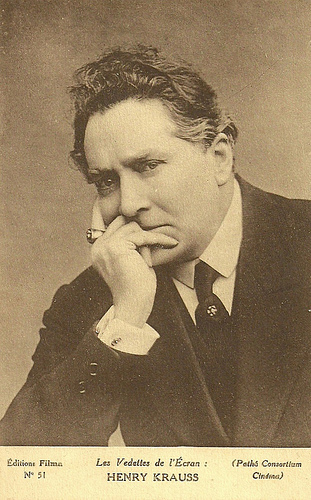
French postcard in the Les Vedettes de l'Ecran Series by Editions Filma, no. 51. Photo: Pathé Consortium Cinéma.
The Hunchback of Notre-Dame
Henry Krauss, sometimes credited as Henri Krauss, was born as Henry Kraus in Paris in 1866.
For two decades he appeared on the stages of Paris in plays like Valet de cœur (1893), La peur des coups (1894) and Théroigne de Méricourt (1902).
In 1908 he discovered the early cinema and played parts in short silent films as L'Arlésienne (Albert Capellani, 1908), based on the play by Alphonse Daudet, and Marie Stuart/Mary Stuart (Albert Capellani, 1908).
In the next five years he played a wealth of powerful leading roles for SCAGL (Société Cinématographique des Auteurs et Gens de Lettres) and Krauss became one of the film studio’s first character stars.
Krauss played Buridau in the film adaptation of Alexandre Dumas' La tour de Nesle/The Tower of Nesle (Albert Capellani, 1909), the title character in the drama Le lépreux de la cité d'Aosta/The leper of the city of Aosta (André Calmettes, 1910), the bohemian in L’oiseau s’envole/The bird flies (Albert Capellani, 1911), Dr. Cezambre in the crime melodrama La glu/The Siren (Albert Capellani, 1913) featuring Mistinguett , and Prince Grégoire III in Le réveil/The alarm (1914).
Before the First World War, he became a star with his interpretations of two characters from novels by Victor Hugo.
In 1911 he starred as Quasimodo in Notre Dame de Paris/The Hunchback of Notre-Dame (Albert Capellani, 1911) opposite Stacia Napierkowska as Esmeralda, and in Les Misérables (Albert Capellani, 1913), he was Jean Valjean, relentlessly pursued by the Justice.
His last starring role before the war was Étienne Lantier in Émile Zola's Germinal (Albert Capellani, 1913) with Sylvie .
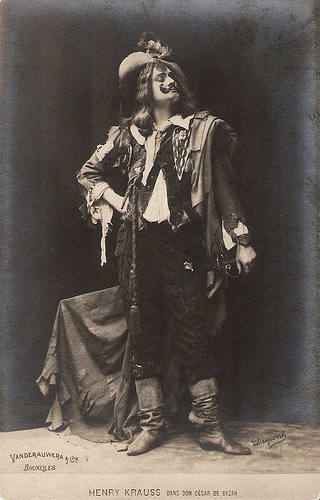
Belgian postcard by VanderAuwera & Cie., Bruxelles. Photo: Dupont. Caption: Henry Krauss in Don César de Bazan. Don César de Bazan is an opéra comique by Jules Massenet, based on the drama Ruy Blas by Victor Hugo.
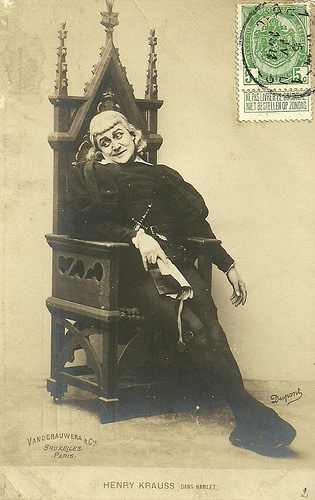
Belgian / French postcard by Vanderauwera & Coe., Bruxelles / Paris. Photo: Dupont. Publicity still of Henry Krauss in Hamlet by William Shakespeare.
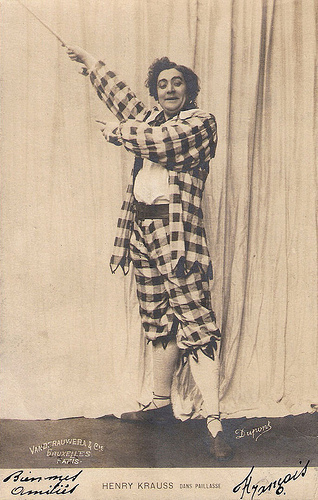
Belgian / French postcard by Vanderauwera & Coe., Bruxelles / Paris. Photo: Dupont. Publicity still of Henry Krauss in the lead role of the stage play Paillasse by Adolphe d'Ennery.
Napoleon
Although Henry Krauss remained active in front of the camera after the war, his star rapidly declined.
He was the uncle of Gina Relly in L'empereur des pauvres/The Emperor of the poor (René LePrince, 1922), and played the lead in Le bossu/The Hunchback (?, 1923) with Claude Mérelle .
In 1925, the nearly 60-year-old artist in 1925 played another signature role again as the father of the title character in Poil de carotte/Carrot hair (Julien Duvivier, 1925).
In the later 1920s and 1930s his acting style was considered too pompous and exaggerated.
Krauss occasionally worked as a director. In 1925/26 he was an assistant director to Abel Gance at the classic epic Napoleon.
He had a supporting part in the sound film Le procureur Hallers/The Prosecutor Hallers (Robert Wiene, 1930) starring Jean-Max and Colette Darfeuil .
It was the French-language version of the German film Der Andere/The Other (Robert Wiene, 1930) based on the play Der Andere by Paul Lindau. The two films were made at the same studio in Berlin, with Wiene beginning work on the French version immediately after finishing the German film.
Over two decades after his Jean Valjean interpretation in Les Miserables (1913), Henry Krauss also appeared in the first sound film version of the Hugo-adaptation, Les misérables (Raymond Bernard, 1934). This time Harry Baur interpreted Jean Valjean and Krauss had to be content with the much smaller role of Mgr. Myriel.
At the age of 69, Henry Krauss died in 1935 in his hometown Paris. His son was the art director Jacques Krauss.
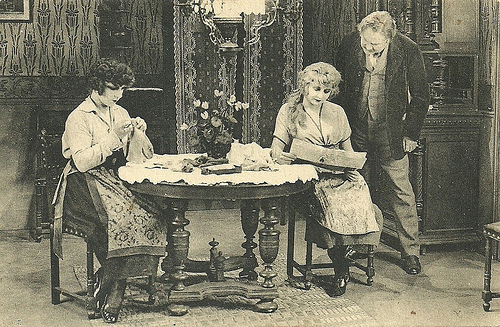
French postcard by M. Le Deley, Paris. Photo: Pathé Consortium Cinéma. Publicity still for L'empereur des pauvres/The Emperor of the poor (René Leprince, 1921). In the middle, Gina Relly as Sylvette, and right, Henry Krauss, as her uncle Jean Sarrias, revolting against society. Left could be Andrée Pascal as Clémence Sarrias.
Sources: Wikipedia (French, German and English) and

French postcard in the Les Vedettes de l'Ecran Series by Editions Filma, no. 51. Photo: Pathé Consortium Cinéma.
The Hunchback of Notre-Dame
Henry Krauss, sometimes credited as Henri Krauss, was born as Henry Kraus in Paris in 1866.
For two decades he appeared on the stages of Paris in plays like Valet de cœur (1893), La peur des coups (1894) and Théroigne de Méricourt (1902).
In 1908 he discovered the early cinema and played parts in short silent films as L'Arlésienne (Albert Capellani, 1908), based on the play by Alphonse Daudet, and Marie Stuart/Mary Stuart (Albert Capellani, 1908).
In the next five years he played a wealth of powerful leading roles for SCAGL (Société Cinématographique des Auteurs et Gens de Lettres) and Krauss became one of the film studio’s first character stars.
Krauss played Buridau in the film adaptation of Alexandre Dumas' La tour de Nesle/The Tower of Nesle (Albert Capellani, 1909), the title character in the drama Le lépreux de la cité d'Aosta/The leper of the city of Aosta (André Calmettes, 1910), the bohemian in L’oiseau s’envole/The bird flies (Albert Capellani, 1911), Dr. Cezambre in the crime melodrama La glu/The Siren (Albert Capellani, 1913) featuring Mistinguett , and Prince Grégoire III in Le réveil/The alarm (1914).
Before the First World War, he became a star with his interpretations of two characters from novels by Victor Hugo.
In 1911 he starred as Quasimodo in Notre Dame de Paris/The Hunchback of Notre-Dame (Albert Capellani, 1911) opposite Stacia Napierkowska as Esmeralda, and in Les Misérables (Albert Capellani, 1913), he was Jean Valjean, relentlessly pursued by the Justice.
His last starring role before the war was Étienne Lantier in Émile Zola's Germinal (Albert Capellani, 1913) with Sylvie .

Belgian postcard by VanderAuwera & Cie., Bruxelles. Photo: Dupont. Caption: Henry Krauss in Don César de Bazan. Don César de Bazan is an opéra comique by Jules Massenet, based on the drama Ruy Blas by Victor Hugo.

Belgian / French postcard by Vanderauwera & Coe., Bruxelles / Paris. Photo: Dupont. Publicity still of Henry Krauss in Hamlet by William Shakespeare.

Belgian / French postcard by Vanderauwera & Coe., Bruxelles / Paris. Photo: Dupont. Publicity still of Henry Krauss in the lead role of the stage play Paillasse by Adolphe d'Ennery.
Napoleon
Although Henry Krauss remained active in front of the camera after the war, his star rapidly declined.
He was the uncle of Gina Relly in L'empereur des pauvres/The Emperor of the poor (René LePrince, 1922), and played the lead in Le bossu/The Hunchback (?, 1923) with Claude Mérelle .
In 1925, the nearly 60-year-old artist in 1925 played another signature role again as the father of the title character in Poil de carotte/Carrot hair (Julien Duvivier, 1925).
In the later 1920s and 1930s his acting style was considered too pompous and exaggerated.
Krauss occasionally worked as a director. In 1925/26 he was an assistant director to Abel Gance at the classic epic Napoleon.
He had a supporting part in the sound film Le procureur Hallers/The Prosecutor Hallers (Robert Wiene, 1930) starring Jean-Max and Colette Darfeuil .
It was the French-language version of the German film Der Andere/The Other (Robert Wiene, 1930) based on the play Der Andere by Paul Lindau. The two films were made at the same studio in Berlin, with Wiene beginning work on the French version immediately after finishing the German film.
Over two decades after his Jean Valjean interpretation in Les Miserables (1913), Henry Krauss also appeared in the first sound film version of the Hugo-adaptation, Les misérables (Raymond Bernard, 1934). This time Harry Baur interpreted Jean Valjean and Krauss had to be content with the much smaller role of Mgr. Myriel.
At the age of 69, Henry Krauss died in 1935 in his hometown Paris. His son was the art director Jacques Krauss.

French postcard by M. Le Deley, Paris. Photo: Pathé Consortium Cinéma. Publicity still for L'empereur des pauvres/The Emperor of the poor (René Leprince, 1921). In the middle, Gina Relly as Sylvette, and right, Henry Krauss, as her uncle Jean Sarrias, revolting against society. Left could be Andrée Pascal as Clémence Sarrias.
Sources: Wikipedia (French, German and English) and
Published on August 10, 2014 23:00
August 9, 2014
Dagli Appennini alle Ande (1916)
We start a new, weekly series of film specials at EFSP. Today, a post about a quite unknown Italian film from the silent era, Dagli Appennini alle Ande/From the Apennines to the Andes (1916), based on a story by Edmondo De Amicis from the volume Cuore (Heart). The film was directed by Umberto Paradisi and starred Ermanno Roveri as little Marco. A series of 8 sepia postcards was published for the film.
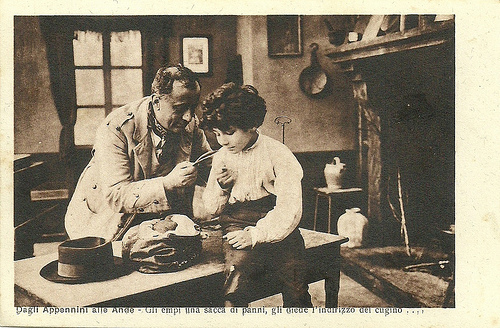
Italian postcard by Stabilimenti Alterocca, Terni. Photo: Gloria Film. Publicity still for Dagli Appennini alle Ande (Umberto Paradisi, 1916). Caption: He filled a sack with clothes for him, and gave him the address of the cousin.
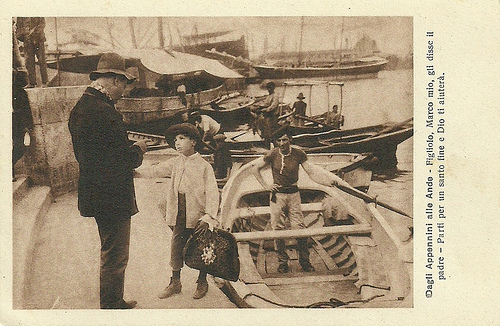
Italian postcard by Stabilimenti Alterocca, Terni. Photo: Gloria Film. Publicity still for Dagli Appennini alle Ande (Umberto Paradisi, 1916). Caption: My son, my Marco, the father said to him, you have set out on a holy undertaking, and God will aid you.
A sheer endless trip
The story of Dagli Appennini alle Ande/From the Apennines to the Andes narrates about a poor boy from Genoa, Marco (played by the then twelve years old Ermanno Roveri ), whose mother is working in Argentine and has not responded to the mail from Italy anymore.
His father and oldest brother cannot leave work, so young Marco leaves to make the big journey, helped and waved goodbye by his father. He sails from Genoa to Buenos Aires.
In Buenos Aires he discovers that his parent's cousin Francesco Merelli, who had helped as an intermediate has died, and that his mother has moved to Cordova, together with the family she works for.
This is the start from a sheer endless trip through the country, with Marco always discovering that the family has moved to yet another city.
Re-meeting an old Italian he met before on the ocean liner, the man pities Marco and raises money in a bar to help him.
Marco pleas to a man with a cart (the head of a convoy of wagons) to take him along, which the guy first refuses but then accepts, in trade of Marco doing hard work for him. When the boy falls ill, the man pities him and takes care of him.
After more hardship, including a walk for miles and miles, Marco finally finds his mother, who had fallen ill and had refused to be operated. Now she will and she will be saved as well.
Marco's mother was played by Fernanda Roveri, Ermanno's real mother.
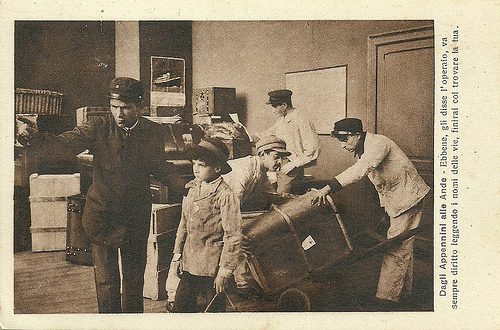
Italian postcard by Stabilimenti Alterocca, Terni. Photo: Gloria Film. Publicity still for Dagli Appennini alle Ande (Umberto Paradisi, 1916). Caption: “Well, then,” said the labourer, “keep straight on through there, reading the names of all the streets on the corners; you will end by finding the one you want.”
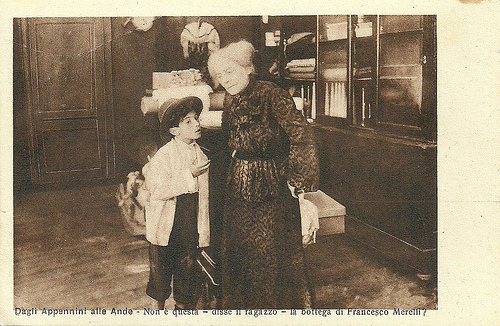
Italian postcard by Stabilimenti Alterocca, Terni. Photo: Gloria Film. Publicity still for Dagli Appennini alle Ande (Umberto Paradisi, 1916). Caption: "Is not this,” said the boy, “the shop of Francesco Merelli?”
A more refined idea
In 1994, Dagli Appennini alle Ande (1916) was restored and presented at the Cinema Ritrovato festival in Bologna.
Vittorio Martinelli wrote in the catalogue: "Film Artistica Gloria was the first film company to understand that to support, through cinema, the war effort during World War I, you could not, as most of the production houses were doing, rely on a ridiculous strongmen as Maciste or on a comedian as Cretinetti who succeeded to bring down a whole regiment of Krauts with his jokes and to win the war.
Gloria had a more refined idea and adapted for the screen the stories from the book Cuore (Heart), where the heroes were young Italians who sacrificed themselves for their country and fought against the enemies at all time, even in distant wars."
Dagli Appennini alle Ande had a good reception in Italy. During World War II, a new sound version was produced, Dagli Appennini alle Ande (Flavio Calzavara, 1943), starring Cesare Barbetti as Marco and Leda Gloria as his mother.
In 1959 followed again new version, Dagli Appennini alle Ande (Folco Quilici, 1959). The lead roles were played by Marco Paoletti as Marco, Eleonora Rossi Drago as his mother, and Fausto Tozzi as his father.
Finally, there was also a TV mini-series, Dagli Appennini alle Ande (Pino Passalacqua, 1990), with Umberto Caglini as Marco, and Giuliano Gemma .
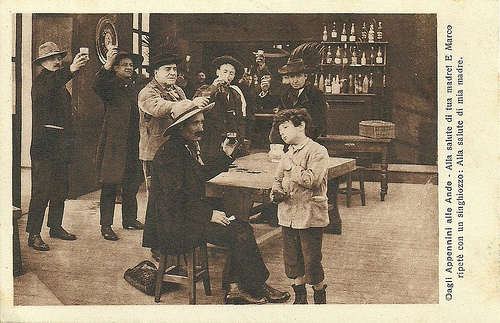
Italian postcard by Stabilimenti Alterocca, Terni. Photo: Gloria Film. Publicity still for Dagli Appennini alle Ande (Umberto Paradisi, 1916). Caption: “To the health of your mother!” And Marco repeated, sobbing, “To the health of my mother.”
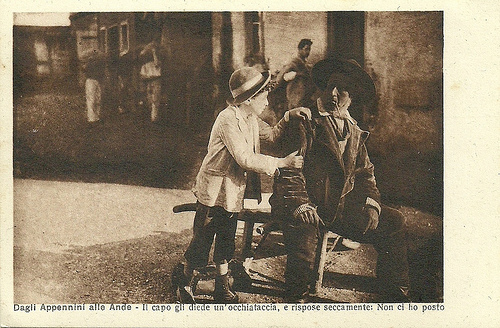
Italian postcard by Stabilimenti Alterocca, Terni. Photo: Gloria Film. Publicity still for Dagli Appennini alle Ande (Umberto Paradisi, 1916). Caption: The head [the head conductor of the convoy of wagons] surveyed him with a keen glance, and replied drily, “I have no place.”
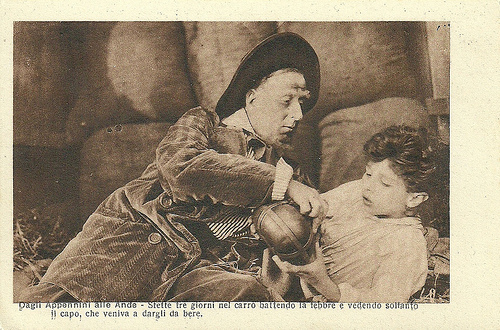
Italian postcard by Stabilimenti Alterocca, Terni. Photo: Gloria Film. Publicity still for Dagli Appennini alle Ande (Umberto Paradisi, 1916). Caption: For three days he remained in the wagon, fighting a fever, and seeing no one except the head, who came to give him to drink.
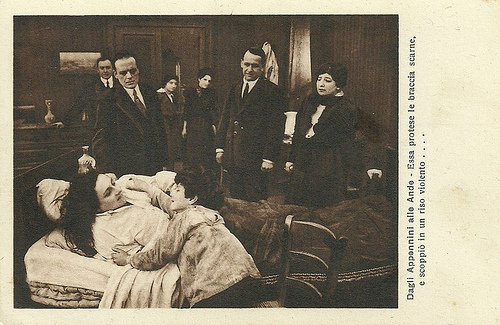
Italian postcard by Stabilimenti Alterocca, Terni. Photo: Gloria Film. Publicity still for Dagli Appennini alle Ande (Umberto Paradisi, 1916). Caption: She stretched out to him her fleshless arms, and she burst into a violent laugh.
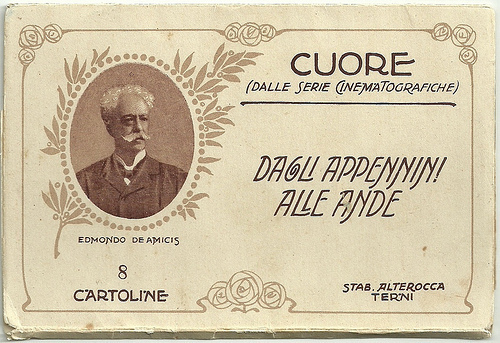
Italian postcard by Stabilimenti Alterocca, Terni. Photo: Gloria Film. This is the cover of the complete series of 8 postcards for Dagli Appennini alle Ande (1916).
Some of the postcards depict situations differently from the film. For the full film of 37 minutes, see Cinestore of Cineteca di Bologna. See also: De amicis Letteratura opera omnia.
In the right column you will find the film specials that we have posted in the past.
Source: Wikipedia (Italian) and IMDb.

Italian postcard by Stabilimenti Alterocca, Terni. Photo: Gloria Film. Publicity still for Dagli Appennini alle Ande (Umberto Paradisi, 1916). Caption: He filled a sack with clothes for him, and gave him the address of the cousin.

Italian postcard by Stabilimenti Alterocca, Terni. Photo: Gloria Film. Publicity still for Dagli Appennini alle Ande (Umberto Paradisi, 1916). Caption: My son, my Marco, the father said to him, you have set out on a holy undertaking, and God will aid you.
A sheer endless trip
The story of Dagli Appennini alle Ande/From the Apennines to the Andes narrates about a poor boy from Genoa, Marco (played by the then twelve years old Ermanno Roveri ), whose mother is working in Argentine and has not responded to the mail from Italy anymore.
His father and oldest brother cannot leave work, so young Marco leaves to make the big journey, helped and waved goodbye by his father. He sails from Genoa to Buenos Aires.
In Buenos Aires he discovers that his parent's cousin Francesco Merelli, who had helped as an intermediate has died, and that his mother has moved to Cordova, together with the family she works for.
This is the start from a sheer endless trip through the country, with Marco always discovering that the family has moved to yet another city.
Re-meeting an old Italian he met before on the ocean liner, the man pities Marco and raises money in a bar to help him.
Marco pleas to a man with a cart (the head of a convoy of wagons) to take him along, which the guy first refuses but then accepts, in trade of Marco doing hard work for him. When the boy falls ill, the man pities him and takes care of him.
After more hardship, including a walk for miles and miles, Marco finally finds his mother, who had fallen ill and had refused to be operated. Now she will and she will be saved as well.
Marco's mother was played by Fernanda Roveri, Ermanno's real mother.

Italian postcard by Stabilimenti Alterocca, Terni. Photo: Gloria Film. Publicity still for Dagli Appennini alle Ande (Umberto Paradisi, 1916). Caption: “Well, then,” said the labourer, “keep straight on through there, reading the names of all the streets on the corners; you will end by finding the one you want.”

Italian postcard by Stabilimenti Alterocca, Terni. Photo: Gloria Film. Publicity still for Dagli Appennini alle Ande (Umberto Paradisi, 1916). Caption: "Is not this,” said the boy, “the shop of Francesco Merelli?”
A more refined idea
In 1994, Dagli Appennini alle Ande (1916) was restored and presented at the Cinema Ritrovato festival in Bologna.
Vittorio Martinelli wrote in the catalogue: "Film Artistica Gloria was the first film company to understand that to support, through cinema, the war effort during World War I, you could not, as most of the production houses were doing, rely on a ridiculous strongmen as Maciste or on a comedian as Cretinetti who succeeded to bring down a whole regiment of Krauts with his jokes and to win the war.
Gloria had a more refined idea and adapted for the screen the stories from the book Cuore (Heart), where the heroes were young Italians who sacrificed themselves for their country and fought against the enemies at all time, even in distant wars."
Dagli Appennini alle Ande had a good reception in Italy. During World War II, a new sound version was produced, Dagli Appennini alle Ande (Flavio Calzavara, 1943), starring Cesare Barbetti as Marco and Leda Gloria as his mother.
In 1959 followed again new version, Dagli Appennini alle Ande (Folco Quilici, 1959). The lead roles were played by Marco Paoletti as Marco, Eleonora Rossi Drago as his mother, and Fausto Tozzi as his father.
Finally, there was also a TV mini-series, Dagli Appennini alle Ande (Pino Passalacqua, 1990), with Umberto Caglini as Marco, and Giuliano Gemma .

Italian postcard by Stabilimenti Alterocca, Terni. Photo: Gloria Film. Publicity still for Dagli Appennini alle Ande (Umberto Paradisi, 1916). Caption: “To the health of your mother!” And Marco repeated, sobbing, “To the health of my mother.”

Italian postcard by Stabilimenti Alterocca, Terni. Photo: Gloria Film. Publicity still for Dagli Appennini alle Ande (Umberto Paradisi, 1916). Caption: The head [the head conductor of the convoy of wagons] surveyed him with a keen glance, and replied drily, “I have no place.”

Italian postcard by Stabilimenti Alterocca, Terni. Photo: Gloria Film. Publicity still for Dagli Appennini alle Ande (Umberto Paradisi, 1916). Caption: For three days he remained in the wagon, fighting a fever, and seeing no one except the head, who came to give him to drink.

Italian postcard by Stabilimenti Alterocca, Terni. Photo: Gloria Film. Publicity still for Dagli Appennini alle Ande (Umberto Paradisi, 1916). Caption: She stretched out to him her fleshless arms, and she burst into a violent laugh.

Italian postcard by Stabilimenti Alterocca, Terni. Photo: Gloria Film. This is the cover of the complete series of 8 postcards for Dagli Appennini alle Ande (1916).
Some of the postcards depict situations differently from the film. For the full film of 37 minutes, see Cinestore of Cineteca di Bologna. See also: De amicis Letteratura opera omnia.
In the right column you will find the film specials that we have posted in the past.
Source: Wikipedia (Italian) and IMDb.
Published on August 09, 2014 23:00
August 8, 2014
New rares from Didier Hanson
A friend who contributes lots and lots of postcards to this site is Didier Hanson. From Spain, he regularly sends me new scans of vintage film postcards he discovered. His collection must be gigantic, but the quality is even more impressing. Time after time, a film museum or a collector writes me how amazed they are about Didier's Russian Vera Kholodnaya cards or about the Hungarian postcard of the young Bela Lugosi (photo: Angelo). Didier himself is also a huge fan of silent diva Lya de Putti, because she reminds him of his wife. But he also likes vintage postcards of forgotten actors of the silent European cinema, many of whom were dancers. This post presents some of these rare cards, he has sent me recently.
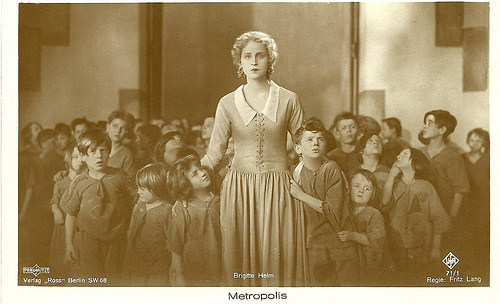
German postcard by Ross Verlag, Berlin, no. 71/1. Photo: Ufa / Parufamet. Publicity still for Metropolis (Fritz Lang, 1927) with Brigitte Helm . Collection: Didier Hanson. Tomorrow, EFSP will start a new series of weekly film specials in which Metropolis will be included.
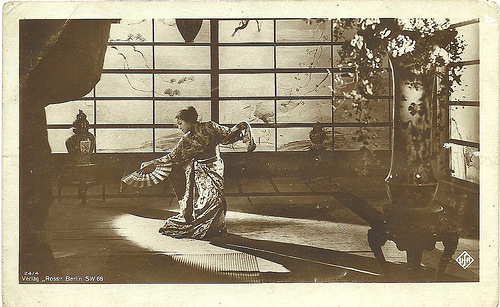
German postcard by Ross Verlag, Berlin, no. 24/4. Photo: Ufa. Publicity still for Wege zu Kraft und Schönheit/Ways to Strength and Beauty (Nicholas Kaufmann, Wilhelm Prager, 1925). Collection: Didier Hanson.
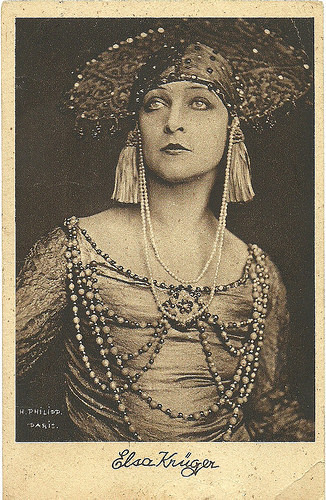
German postcard by Georg A. Jasmatzi Aktiengesellschaft, Dresden. Photo: H. Philipp, Paris. Collection: Didier Hanson.
Russian dancer and actress Elsa Krüger (1893-1941) started to perform in modern dances in 1913. Soon she was a star, named 'queen of tango'. She starred in one of the best films of the Russian empire, Nemye svideteli/Silent Witnesses (Yevgeny Bauer, 1914) as the attractive, cold-hearted, manipulative Yelena. After the revolution, she opened the Russian Romantic Ballet Theatre (Russische romantische Ballett) in Berlin and also appeared in a few German films.
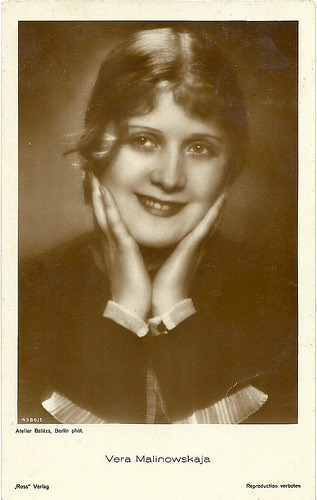
German postcard by Ross Verlag, no. 4386/1, 1929-1930. Photo: Atelier Balázs, Berlin. Collection: Didier Hanson.
Vera Malinovskaya (1900-1988), also written as Malinovskaja/ Malinovskaia, played in several Russian films of the 1920s and a few in Germany and Austria.
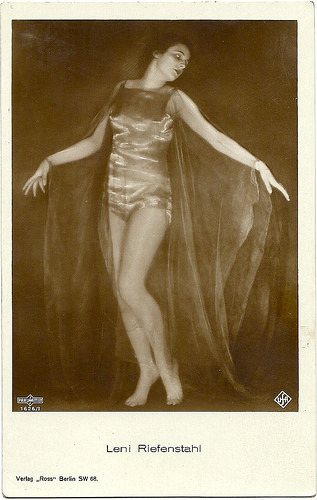
German postcard by Ross Verlag, no. 1626/1, 1927-1928. Photo: Ufa / Parufamet. Collection: Didier Hanson.
Leni Riefenstahl (1902-2003) was the notorious director of Triumph des Willens (1935), a fascinating propaganda documentary about Adolf Hitler and the Third Reich, commissioned by the Nazi government. Before she started directing films, she worked as a dancer and on screen she became a star in the mountain films, directed by Arnold Fanck.
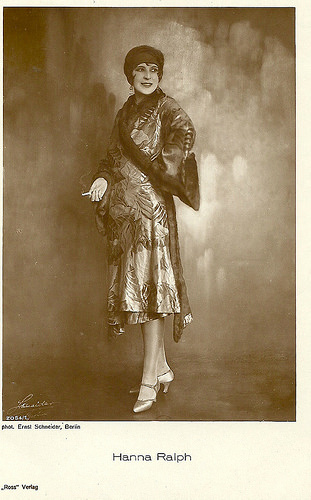
German postcard by Ross Verlag, no. 2054/1, 1927-1928. Photo: Ernst Schneider, Berlin. Collection: Didier Hanson.
Stage actress Hanna Ralph (1885-1978) had also a prominent career in the silent cinema. She is best known as Brunhild in Fritz Lang's Die Nibelungen: Siegfried (1924). She also appeared in F.W. Murnau's Faust - Eine deutsche Volkssage (1926) and was married to its star, Emil Jannings .
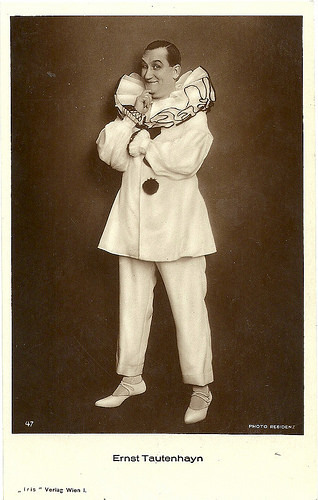
Austrian postcard by Iris-Verlag, no. 47. Photo: Residenz. Collection: Didier Hanson.
Austrian actor Ernst Tautenhayn (1874–1944) appeared in silent films of the late 1910s and early 1920s.
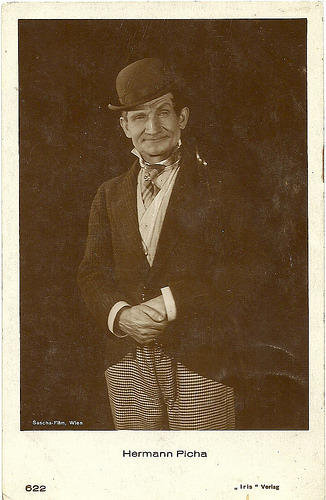
Austrian postcard by Iris-Verlag, no. 522. Photo: Sascha-Film, Wien (Vienna). Collection: Didier Hanson.
German actor Hermann Picha (1865-1936) played character roles in many classics of the Weimar cinema, such as Fritz Langs's Der müde Tod/Destiny (1921), F.W. Murnau's Herr Tartüff/Tartuffe (1925), and Der Hauptmann von Köpenick/The Captain from Koepenick (Siegfried Dessauer, 1926).
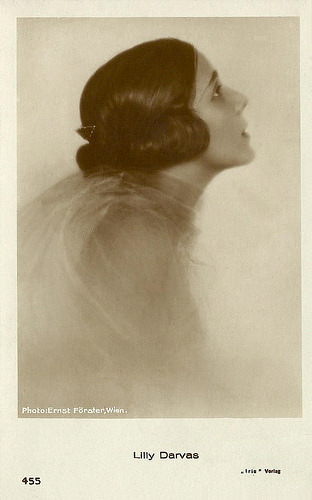
Austrian postcard by Iris-Verlag, no. 455. Photo: Ernst Förster, Wien (Vienna). Collection: Didier Hanson.
Hungarian-born Lili or Lilly Darvas (1902-1974) was a major star first in Budapest, then on the German stage with Max Reinhardt's theatre company during the 1920s. In 1926, Lili married the playwright Ferenc Molnár, who wrote several plays for her.The following year, she made her Broadway debut as Titania in A Midsummer Night's Dream. After the Austrian Anschluss in 1938, the Jewish actress fled to the US. In Hollywood, she appeared in the MGM musical Meet Me in Las Vegas (Roy Rowland, 1956).
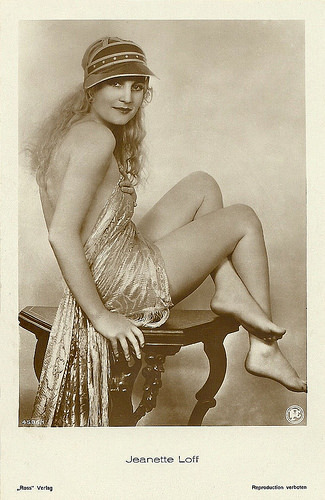
German postcard by Ross Verlag, no. 4596/1, 1929-1930. Photo: PDC. Collection: Didier Hanson.
American beauty Jeanette Loff (1906-1942) made her film debut in Uncle Tom's Cabin (Harry A. Pollard, 1927) . Cecil B. Demille offered her a contract and she quickly became one of Hollywood busiest starlets. Jeanette got the chance to show off her soprano voice in films like King Of Jazz (John Murray Anderson, 1930) and Party Girl (Victor Halperin, 1930). Later she starred in several Broadway shows. She retired from acting and in 1942 she died after ingesting ammonia. She was only thirty-five years old.
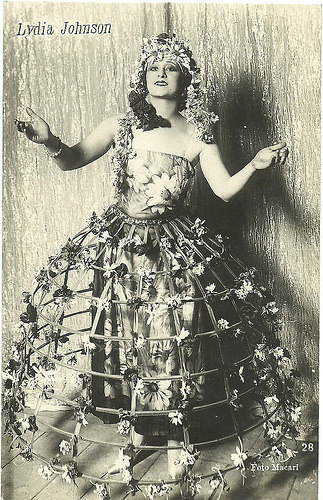
Italian postcard, no. 28. Photo: Macari. Collection: Didier Hanson.
Russian actress Lydia Johnson (1896-1969) made a few films in Russia, just before the revolution started. She fled to Turkey and finally settled in Italy.
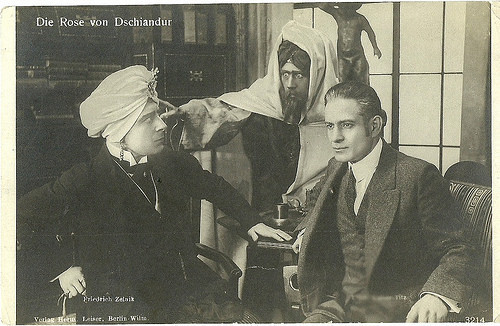
German postcard by Verlag Hermann Leiser, Berlin-Wilm., no. 3214. Photo: publicity still for Die Rose von Dschiandur/The Rose of Dschiandur (Alfred Halm, 1918) with Friedrich Zelnik and Erich Kaiser-Titz . Collection: Didier Hanson.
Muchos gracias, amigo!
Sources: Verbinina and IMDb.

German postcard by Ross Verlag, Berlin, no. 71/1. Photo: Ufa / Parufamet. Publicity still for Metropolis (Fritz Lang, 1927) with Brigitte Helm . Collection: Didier Hanson. Tomorrow, EFSP will start a new series of weekly film specials in which Metropolis will be included.

German postcard by Ross Verlag, Berlin, no. 24/4. Photo: Ufa. Publicity still for Wege zu Kraft und Schönheit/Ways to Strength and Beauty (Nicholas Kaufmann, Wilhelm Prager, 1925). Collection: Didier Hanson.

German postcard by Georg A. Jasmatzi Aktiengesellschaft, Dresden. Photo: H. Philipp, Paris. Collection: Didier Hanson.
Russian dancer and actress Elsa Krüger (1893-1941) started to perform in modern dances in 1913. Soon she was a star, named 'queen of tango'. She starred in one of the best films of the Russian empire, Nemye svideteli/Silent Witnesses (Yevgeny Bauer, 1914) as the attractive, cold-hearted, manipulative Yelena. After the revolution, she opened the Russian Romantic Ballet Theatre (Russische romantische Ballett) in Berlin and also appeared in a few German films.

German postcard by Ross Verlag, no. 4386/1, 1929-1930. Photo: Atelier Balázs, Berlin. Collection: Didier Hanson.
Vera Malinovskaya (1900-1988), also written as Malinovskaja/ Malinovskaia, played in several Russian films of the 1920s and a few in Germany and Austria.

German postcard by Ross Verlag, no. 1626/1, 1927-1928. Photo: Ufa / Parufamet. Collection: Didier Hanson.
Leni Riefenstahl (1902-2003) was the notorious director of Triumph des Willens (1935), a fascinating propaganda documentary about Adolf Hitler and the Third Reich, commissioned by the Nazi government. Before she started directing films, she worked as a dancer and on screen she became a star in the mountain films, directed by Arnold Fanck.

German postcard by Ross Verlag, no. 2054/1, 1927-1928. Photo: Ernst Schneider, Berlin. Collection: Didier Hanson.
Stage actress Hanna Ralph (1885-1978) had also a prominent career in the silent cinema. She is best known as Brunhild in Fritz Lang's Die Nibelungen: Siegfried (1924). She also appeared in F.W. Murnau's Faust - Eine deutsche Volkssage (1926) and was married to its star, Emil Jannings .

Austrian postcard by Iris-Verlag, no. 47. Photo: Residenz. Collection: Didier Hanson.
Austrian actor Ernst Tautenhayn (1874–1944) appeared in silent films of the late 1910s and early 1920s.

Austrian postcard by Iris-Verlag, no. 522. Photo: Sascha-Film, Wien (Vienna). Collection: Didier Hanson.
German actor Hermann Picha (1865-1936) played character roles in many classics of the Weimar cinema, such as Fritz Langs's Der müde Tod/Destiny (1921), F.W. Murnau's Herr Tartüff/Tartuffe (1925), and Der Hauptmann von Köpenick/The Captain from Koepenick (Siegfried Dessauer, 1926).

Austrian postcard by Iris-Verlag, no. 455. Photo: Ernst Förster, Wien (Vienna). Collection: Didier Hanson.
Hungarian-born Lili or Lilly Darvas (1902-1974) was a major star first in Budapest, then on the German stage with Max Reinhardt's theatre company during the 1920s. In 1926, Lili married the playwright Ferenc Molnár, who wrote several plays for her.The following year, she made her Broadway debut as Titania in A Midsummer Night's Dream. After the Austrian Anschluss in 1938, the Jewish actress fled to the US. In Hollywood, she appeared in the MGM musical Meet Me in Las Vegas (Roy Rowland, 1956).

German postcard by Ross Verlag, no. 4596/1, 1929-1930. Photo: PDC. Collection: Didier Hanson.
American beauty Jeanette Loff (1906-1942) made her film debut in Uncle Tom's Cabin (Harry A. Pollard, 1927) . Cecil B. Demille offered her a contract and she quickly became one of Hollywood busiest starlets. Jeanette got the chance to show off her soprano voice in films like King Of Jazz (John Murray Anderson, 1930) and Party Girl (Victor Halperin, 1930). Later she starred in several Broadway shows. She retired from acting and in 1942 she died after ingesting ammonia. She was only thirty-five years old.

Italian postcard, no. 28. Photo: Macari. Collection: Didier Hanson.
Russian actress Lydia Johnson (1896-1969) made a few films in Russia, just before the revolution started. She fled to Turkey and finally settled in Italy.

German postcard by Verlag Hermann Leiser, Berlin-Wilm., no. 3214. Photo: publicity still for Die Rose von Dschiandur/The Rose of Dschiandur (Alfred Halm, 1918) with Friedrich Zelnik and Erich Kaiser-Titz . Collection: Didier Hanson.
Muchos gracias, amigo!
Sources: Verbinina and IMDb.
Published on August 08, 2014 23:00
August 7, 2014
Mylène Farmer
Canadian-born French pop superstar Mylène Farmer (1961) is a singer, songwriter, writer, entrepreneur and an occasional film actress. She holds the record for the most number one hits in the French charts and has sold more than 30 million records.
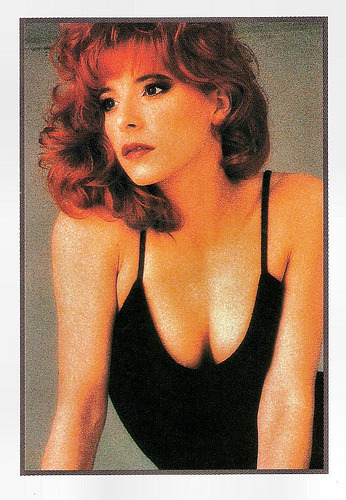
French postcard, no. DK 602.
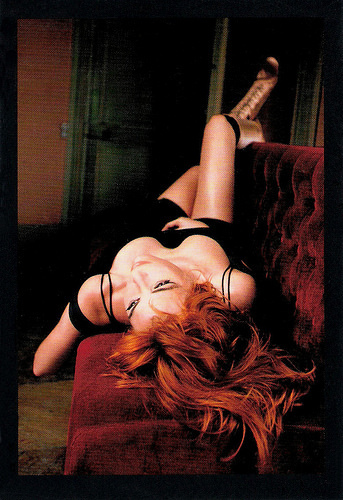
French postcard by Stuffed Monkey / Universal / Polydor. Photo: Dominique Issermann. Design: Henry Neu.
Controversial, poetic and explicit
Mylène Farmer was born Mylène Jeanne Gautier in Montréal ( IMDb ), Quebec or in Pierrefonds, France ( Wikipedia ) or in 1961.
Her parents moved from France to Canada in the late 1950s as Farmer's father, Max, pursued an engineering contract on a dam. Her family moved back to France when she was eight, settling in the Parisian suburb of Ville-d'Avray.
At the age of 17, Farmer discovered acting and she took a three-year course at the Cours Florent, a drama school in Paris. Changing her name to Mylène Farmer as a tribute to her idol, 1930s Hollywood actress Frances Farmer, she began to earn a living as a model acting in several TV ads.
In 1984, Farmer met Laurent Boutonnat, a young film student, after answering a newspaper ad looking for an actress for a small film he was working on. Farmer and Boutonnat became friends and forged a creative partnership, writing and producing the music.
He wrote her first song, Maman a tort, about a young girl's love for her female nurse. It became a mild success in March 1984.
Boutonnat, whose ambition was to become a film director, would be the force behind Mylène’s videos and he wrote the music of her songs. Farmer would write the lyrics.
In the following years, Farmer gained fame with songs featuring controversial yet poetic lyrics and explicit music videos: Libertine, the lead single of her first album, was released in March 1986 and set the tone for Farmer's musical style. The sensual, romantic lyrics were inspired by 19th century literature.
As for the video, which has a running time of over 10 minutes, Boutonnat was inspired by the film Barry Lyndon (Stanley Kubrick, 1975) and the novels by Marquis de Sade, thus giving the video a cinematic style. Farmer, lit by candlelights, is shrouded in mystery and sexual ambiguity. The video contained the first full frontal nudity appearance by a singer on a major music video.
In 1988, Boutonnat and Farmer started to work on her follow-up album, Ainsi soit je.... This darker and more sexually ambigious album, features songs inspired by Charles Baudelaire and Edgar Allan Poe. The album sold 1.8 million copies and the song Pourvu qu'elles soient douces, containing hints of sodomy; became Farmer’s first #1 hit.
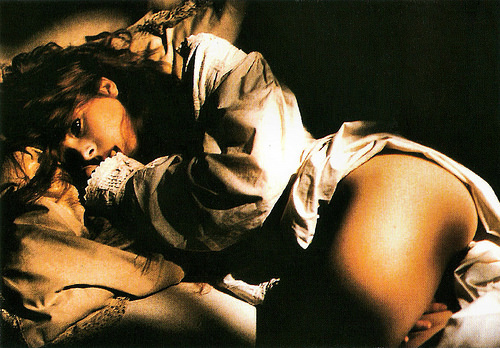
French postcard, no. MF2.
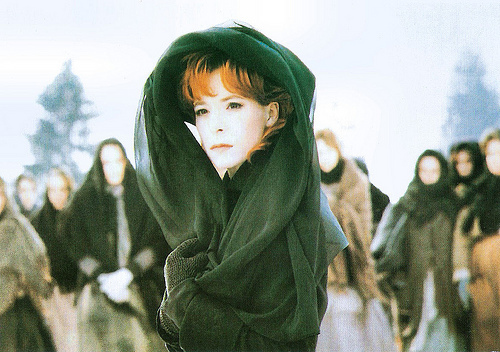
French postcard, no. MF4.
Blood and Sex Charged
Her third album, L'Autre... (1991), and the single Désenchantée made Mylène Farmer a superstar in France. The lyrics approached a larger scope of subjects than before such as religion (Agnus Dei), politics (Désenchantée) and press criticism (Je t'aime mélancolie).
Désenchantée spent 9 weeks atop of the French chart and became one of the best selling French singles of all time. It was also a hit in Belgium, Canada, Austria and the Netherlands. It was accompanied by a video in which Mylène plays a rebelling prisoner in a concentration camp-like facility.
Another successful song of the album, Beyond My Control had a blood-and-sex-charged video that was banned from airplay. The success of the singles helped their parent album sell close to 2 million copies in France alone.
In 1991 a disturbed man who had been stalking Farmer entered the Polydor Records headquarters in Paris, held employees at gunpoint demanding to talk to Farmer, and killed the receptionist. Following this occurrence, Farmer shunned media attention and left France to live in Los Angeles for a few weeks.
In late 1992, she released the remix album Dance Remixes, including the single Que mon cœur lâche, dealing with AIDS and sexual relations. The song was accompanied by a video directed by Luc Besson (the first time that a Farmer video wasn't directed by Boutonnat. In the video Farmer plays an angel sent down to earth by God, to save mankind from itself. God refuses to send Jesus again: "last time it was a disaster”.
In the meantime Farmer starred in Giorgino (1994), the feature debut of Laurent Boutonnat. The 3-hour-plus film, shot in English, was a huge critical and commercial flop. Budgeted at 80 million Francs, it was seen by only 60,000 people and recovered only 1% of its budget. The bad reception was particularly hard on Boutonnat, who would not direct again for 13 years.
Farmer decided to leave France to take a long break in the USA.
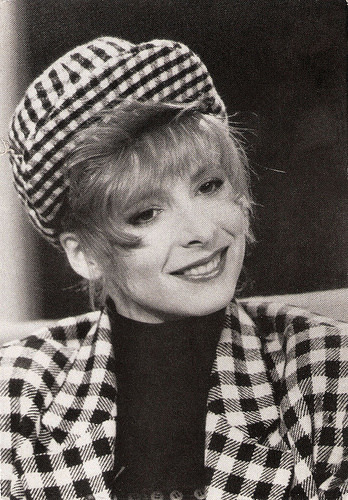
French postcard, no. 201.
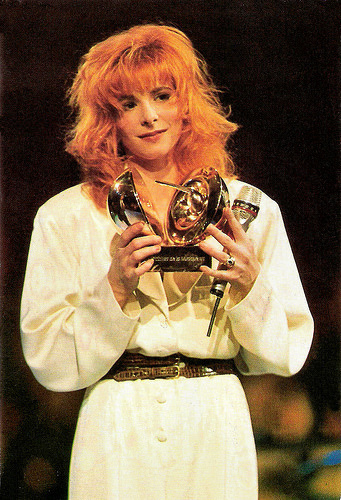
French postcard, no. A104.
Twelve #1 singles
During her time in California, Mylène Farmer started to write her fourth studio album, Anamorphosée. The album was launched by the rock song XXL, and a video directed by Marcus Nispel featuring Mylène strapped to the front of a moving train. The single became her first to debut at #1.
Anamorphosée debuted at #2 in the album charts and sold half a million copies in 3 months. Another single, the jazzy pop ballad California featured a highly acclaimed video directed by Abel Ferrara.
Her 5th studio album Innamoramento went straight to #2 on the charts. The video for the second single, Je te rends ton amour sparked controversy because of its religious imagery. It was condemned by the Catholic Church and banned by many networks. Later released as a video single, it became the biggest selling video single in France.
In late 1999, Farmer embarked on her third concert tour, the Mylenium Tour, which set the record of the highest grossing tour by a non-English speaking artist.
In 2000, Farmer and Boutonnat had assembled songs and video ideas they felt appropriate for a younger, new star, Alizée. They wrote and produced Alizée's albums Gourmandises and Mes courants électriques. Alizée's biggest hit, Moi... Lolita reached the top of the charts and she became the most successful French singer that year.
In December 2004, Farmer presented the album, Avant que l'ombre... which spent several weeks at #1, selling nearly a million copies. Moby invited her to record a duet with him, a French version of Slipping Away - her 4th #1 single in France.
In 2007, Laurent Boutonnat, directed his second feature film, Jacquou le Croquant (2007), featuring Gaspard Ulliel. Farmer recorded the theme song of the film, Devant soi, for the end credits.
During that period, she also worked on the French version of Luc Besson's animated feature Arthur et les Minimoys/Arthur and the Minimoys (2006), lending her voice to Selenia, the character voiced by Madonna in the international version. She later returned to dub the sequels, Arthur et la vengeance de Maltazard/Arthur 2 – the Revenge of Maltazard (Luc Besson, 2009) and Arthur 3: la guerre des deux mondes/Arthur 3: The War of the Two Worlds (Luc Besson, 2010).
Farmer’s seventh studio album, Point de Suture (2008) contained five #1 singles. Farmer then had a record of nine #1 hits in France, more than any other artist in French music history.
In the latter half of 2010, Mylène Farmer hired RedOne, known for his work with Lady Gaga to produce and write the music for the single Oui mais... non. It hit #1 on the French download chart. Considering the decline in music sales, it's her most successful single since 2002. This also makes her the only French singer to have number-one hits in four consecutive decades.
The following singles, Bleu Noir and Lonely Lisa, hit the top of the charts too, expanding her record with twelve #1 singles.
The album Bleu Noir (2010) was produced by Farmer, RedOne, Moby and Archive. It entered the French album chart at #1 and remained at the top for three consecutive weeks. It was followed by another successful album, Monkey Me (2012).
Mylène Farmer sings Oui Mais... Non (2010). Source: MyleneFarmerVEVO (YouTube).
Mylène Farmer sings Je Te Dis Tout. Source: MyleneFarmerVEVO (YouTube).
Sources: Jason Birchmeier (All Music Guide), Wikipedia and .

French postcard, no. DK 602.

French postcard by Stuffed Monkey / Universal / Polydor. Photo: Dominique Issermann. Design: Henry Neu.
Controversial, poetic and explicit
Mylène Farmer was born Mylène Jeanne Gautier in Montréal ( IMDb ), Quebec or in Pierrefonds, France ( Wikipedia ) or in 1961.
Her parents moved from France to Canada in the late 1950s as Farmer's father, Max, pursued an engineering contract on a dam. Her family moved back to France when she was eight, settling in the Parisian suburb of Ville-d'Avray.
At the age of 17, Farmer discovered acting and she took a three-year course at the Cours Florent, a drama school in Paris. Changing her name to Mylène Farmer as a tribute to her idol, 1930s Hollywood actress Frances Farmer, she began to earn a living as a model acting in several TV ads.
In 1984, Farmer met Laurent Boutonnat, a young film student, after answering a newspaper ad looking for an actress for a small film he was working on. Farmer and Boutonnat became friends and forged a creative partnership, writing and producing the music.
He wrote her first song, Maman a tort, about a young girl's love for her female nurse. It became a mild success in March 1984.
Boutonnat, whose ambition was to become a film director, would be the force behind Mylène’s videos and he wrote the music of her songs. Farmer would write the lyrics.
In the following years, Farmer gained fame with songs featuring controversial yet poetic lyrics and explicit music videos: Libertine, the lead single of her first album, was released in March 1986 and set the tone for Farmer's musical style. The sensual, romantic lyrics were inspired by 19th century literature.
As for the video, which has a running time of over 10 minutes, Boutonnat was inspired by the film Barry Lyndon (Stanley Kubrick, 1975) and the novels by Marquis de Sade, thus giving the video a cinematic style. Farmer, lit by candlelights, is shrouded in mystery and sexual ambiguity. The video contained the first full frontal nudity appearance by a singer on a major music video.
In 1988, Boutonnat and Farmer started to work on her follow-up album, Ainsi soit je.... This darker and more sexually ambigious album, features songs inspired by Charles Baudelaire and Edgar Allan Poe. The album sold 1.8 million copies and the song Pourvu qu'elles soient douces, containing hints of sodomy; became Farmer’s first #1 hit.

French postcard, no. MF2.

French postcard, no. MF4.
Blood and Sex Charged
Her third album, L'Autre... (1991), and the single Désenchantée made Mylène Farmer a superstar in France. The lyrics approached a larger scope of subjects than before such as religion (Agnus Dei), politics (Désenchantée) and press criticism (Je t'aime mélancolie).
Désenchantée spent 9 weeks atop of the French chart and became one of the best selling French singles of all time. It was also a hit in Belgium, Canada, Austria and the Netherlands. It was accompanied by a video in which Mylène plays a rebelling prisoner in a concentration camp-like facility.
Another successful song of the album, Beyond My Control had a blood-and-sex-charged video that was banned from airplay. The success of the singles helped their parent album sell close to 2 million copies in France alone.
In 1991 a disturbed man who had been stalking Farmer entered the Polydor Records headquarters in Paris, held employees at gunpoint demanding to talk to Farmer, and killed the receptionist. Following this occurrence, Farmer shunned media attention and left France to live in Los Angeles for a few weeks.
In late 1992, she released the remix album Dance Remixes, including the single Que mon cœur lâche, dealing with AIDS and sexual relations. The song was accompanied by a video directed by Luc Besson (the first time that a Farmer video wasn't directed by Boutonnat. In the video Farmer plays an angel sent down to earth by God, to save mankind from itself. God refuses to send Jesus again: "last time it was a disaster”.
In the meantime Farmer starred in Giorgino (1994), the feature debut of Laurent Boutonnat. The 3-hour-plus film, shot in English, was a huge critical and commercial flop. Budgeted at 80 million Francs, it was seen by only 60,000 people and recovered only 1% of its budget. The bad reception was particularly hard on Boutonnat, who would not direct again for 13 years.
Farmer decided to leave France to take a long break in the USA.

French postcard, no. 201.

French postcard, no. A104.
Twelve #1 singles
During her time in California, Mylène Farmer started to write her fourth studio album, Anamorphosée. The album was launched by the rock song XXL, and a video directed by Marcus Nispel featuring Mylène strapped to the front of a moving train. The single became her first to debut at #1.
Anamorphosée debuted at #2 in the album charts and sold half a million copies in 3 months. Another single, the jazzy pop ballad California featured a highly acclaimed video directed by Abel Ferrara.
Her 5th studio album Innamoramento went straight to #2 on the charts. The video for the second single, Je te rends ton amour sparked controversy because of its religious imagery. It was condemned by the Catholic Church and banned by many networks. Later released as a video single, it became the biggest selling video single in France.
In late 1999, Farmer embarked on her third concert tour, the Mylenium Tour, which set the record of the highest grossing tour by a non-English speaking artist.
In 2000, Farmer and Boutonnat had assembled songs and video ideas they felt appropriate for a younger, new star, Alizée. They wrote and produced Alizée's albums Gourmandises and Mes courants électriques. Alizée's biggest hit, Moi... Lolita reached the top of the charts and she became the most successful French singer that year.
In December 2004, Farmer presented the album, Avant que l'ombre... which spent several weeks at #1, selling nearly a million copies. Moby invited her to record a duet with him, a French version of Slipping Away - her 4th #1 single in France.
In 2007, Laurent Boutonnat, directed his second feature film, Jacquou le Croquant (2007), featuring Gaspard Ulliel. Farmer recorded the theme song of the film, Devant soi, for the end credits.
During that period, she also worked on the French version of Luc Besson's animated feature Arthur et les Minimoys/Arthur and the Minimoys (2006), lending her voice to Selenia, the character voiced by Madonna in the international version. She later returned to dub the sequels, Arthur et la vengeance de Maltazard/Arthur 2 – the Revenge of Maltazard (Luc Besson, 2009) and Arthur 3: la guerre des deux mondes/Arthur 3: The War of the Two Worlds (Luc Besson, 2010).
Farmer’s seventh studio album, Point de Suture (2008) contained five #1 singles. Farmer then had a record of nine #1 hits in France, more than any other artist in French music history.
In the latter half of 2010, Mylène Farmer hired RedOne, known for his work with Lady Gaga to produce and write the music for the single Oui mais... non. It hit #1 on the French download chart. Considering the decline in music sales, it's her most successful single since 2002. This also makes her the only French singer to have number-one hits in four consecutive decades.
The following singles, Bleu Noir and Lonely Lisa, hit the top of the charts too, expanding her record with twelve #1 singles.
The album Bleu Noir (2010) was produced by Farmer, RedOne, Moby and Archive. It entered the French album chart at #1 and remained at the top for three consecutive weeks. It was followed by another successful album, Monkey Me (2012).
Mylène Farmer sings Oui Mais... Non (2010). Source: MyleneFarmerVEVO (YouTube).
Mylène Farmer sings Je Te Dis Tout. Source: MyleneFarmerVEVO (YouTube).
Sources: Jason Birchmeier (All Music Guide), Wikipedia and .
Published on August 07, 2014 23:00
August 6, 2014
Frankie Vaughan
British pop singer Frankie Vaughan (1928-1999) issued more than 80 recordings in his lifetime. He was known as ‘Mr. Moonlight’ after one of his early hits and was famous for his fancy tuxedo, top hat and cane. He also starred in cabaret shows in New York and Las Vegas, and in several films, including Let’s Make Love (1960) with Marilyn Monroe.
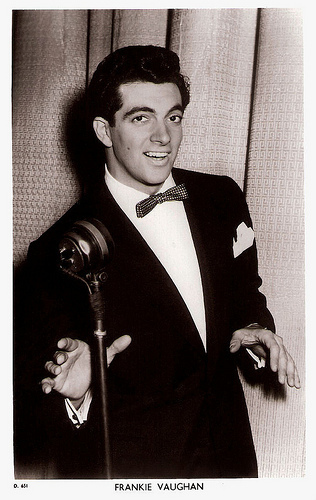
British postcard in the Picturegoer Series, London, no. D. 651.
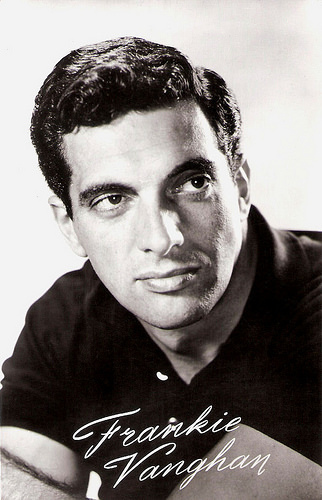
Dutch postcard by Uitgeverij Takken, Utrecht, no. AX 5160.
Delighted squeals from his adoring, mostly female, audience
Frankie Vaughan was born Frank Abelson in Liverpool, England in 1928. He was the son of a Russian-Jewish upholsterer who lived in a poor area of Liverpool. The name 'Vaughan' came from a grandmother whose first grandson he was, who used to call Frank 'my number one' grandson, in whose Russian accent 'one' sounded like 'Vaughan'. He was an evacuee in Lancaster during World War II.
At age 14 he received a scholarship to the Lancaster College of Art, where he sang in the dance band. After a stint in the Royal Army Medical Corps in World War II, he returned to art school, this time the Leeds College of Art. There he gained his Art Teacher's Diploma in 1950. When he won a prize to design a furniture exhibition stand, he left for London.
In London, Vaughan won the second prize on a radio talent show, and began his theatre career doing variety song and dance acts. He was known as a fancy dresser, wearing top hat, bow tie, tails, and cane.
In the 1950’s he worked for a few years with the Nat Temple band, and after that period he began making records, and became very popular in the UK. His first hit was Look at That Girl (1953) with Ken Mackintosh and his orchestra.
In 1955, he recorded what was to become his trademark song, Give Me the Moonlight, Give Me the Girl. He recorded a large number of songs that were covers of United States hit songs, including Jim Lowe's The Green Door (1956), The Garden of Eden (1957) and Jimmie Rodgers' Kisses Sweeter than Wine (1958).
His singing was reportedly accompanied by delighted squeals from his adoring, mostly female, audience. In early 1957 his cover of The Green Door reached #1 in the UK Singles Chart. The same year he was voted 'Showbusiness Personality of the Year'.
In 1961 Vaughan hit #1 for the second time in the UK with Tower of Strength, but the rise of beat music eclipsed his chart career for two or three years, before he returned to the Top 10 in 1967 with There Must Be A Way. Chart success eluded him after this although he did have two more Top 40 singles: Nevertheless and So Tired.
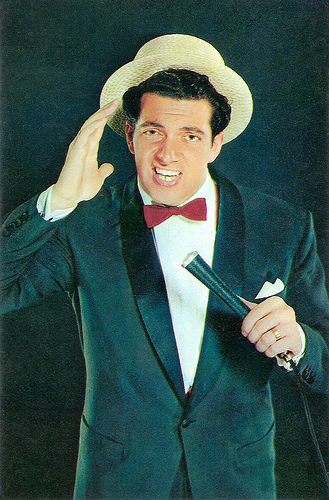
British postcard by Greaves Gravure, Scarborough, no. X 3.
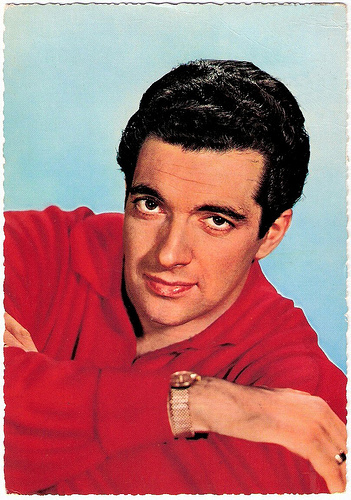
German postcard by Krüger. Sent by mail in the Netherlands in 1964.
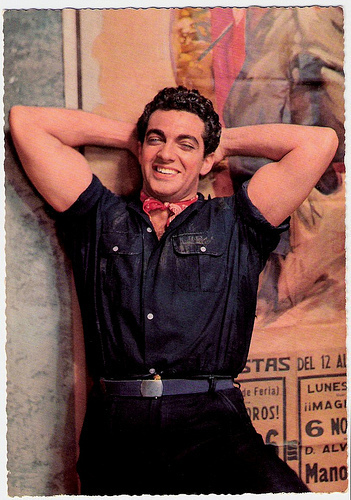
German postcard by Krüger, no. 902/24. Photo: Terb Agency.
Let's Make Love
During the 1950s, Frankie Vaughan appeared in a series of British film musicals including Dangerous Youth (Herbert Wilcox, 1957) with Carole Leslie , and The Lady Is a Square (Herbert Wilcox, 1959) opposite Anna Neagle .
In 1960, he went to the United States to make Let's Make Love (George Cukor, 1960) with Marilyn Monroe. In Let’s Make Love, Vaughan had some nice numbers to sing.
That same year he appeared in another Hollywood film, The Right Approach (David Butler, 1961) with Martha Hyer, but his recordings were no chart hits in the USA.
In 1961 Vaughan returned to England and he was on the bill at the Royal Variety Performance at the Prince of Wales Theatre.
In the late 1960s, he became involved with youth social problems in Easterhouse, a large housing estate in the outskirts of Glasgow, and was influential in attracting new resources and inward investment to the area.
Vaughan continued performing until 1985, when he starred to great critical acclaim in a stage version of 42nd Street at Drury Lane in London. He played a Broadway producer opposite his old friend Shani Wallis who had appeared in their first film together, the Western comedy Ramsbottom Rides Again (John Baxter, 1956). After a year, he suffered a near fatal bout of peritonitis and had to leave the cast.
Frankie Vaughan was created an OBE (Officer of the Order of the British Empire) in 1965, and a CBE (Commander of the Order of the British Empire) in 1996.
Frankie Vaughan died in 1999 from heart failure in Buckinghamshire, England, aged 71. According to the BBC obituary by Nick Higham, Vaughan was married to Stella Shock, from 1951 to 1999 and they had three children and several grandchildren. The Frankie Vaughan Archive, consisting of sheet music, scores, orchestral and band parts, was donated to Liverpool John Moores University by his widow Stella Vaughan in the summer of 2000.
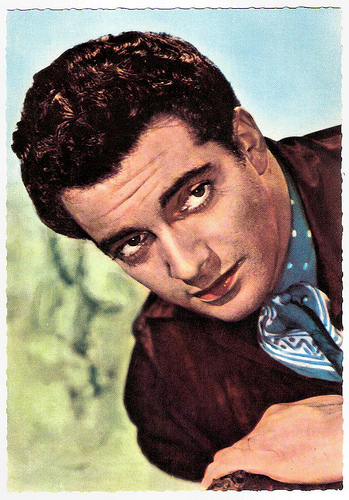
German postcard by ISV, no. H 18.
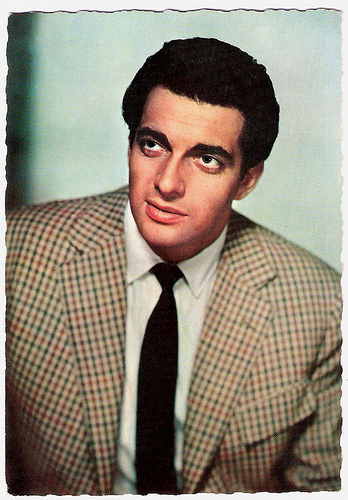
French posrcard by E.D.U.G., no. 50.
Marilyn Monroe and Frankie Vaughan sing the title song in Let's make love (1960) - with Polish subtitles! Source: dorcia72 (YouTube).
Frankie Vaughan's Garden of Eden mimed by characters from the TV series Lipstick on Your Collar (1993) with Ewan McGregor. Source: Lipstick OYC (YouTube).
Sources: Denis Gifford (The Independent), Nick Higham (BBC), Wikipedia, and

British postcard in the Picturegoer Series, London, no. D. 651.

Dutch postcard by Uitgeverij Takken, Utrecht, no. AX 5160.
Delighted squeals from his adoring, mostly female, audience
Frankie Vaughan was born Frank Abelson in Liverpool, England in 1928. He was the son of a Russian-Jewish upholsterer who lived in a poor area of Liverpool. The name 'Vaughan' came from a grandmother whose first grandson he was, who used to call Frank 'my number one' grandson, in whose Russian accent 'one' sounded like 'Vaughan'. He was an evacuee in Lancaster during World War II.
At age 14 he received a scholarship to the Lancaster College of Art, where he sang in the dance band. After a stint in the Royal Army Medical Corps in World War II, he returned to art school, this time the Leeds College of Art. There he gained his Art Teacher's Diploma in 1950. When he won a prize to design a furniture exhibition stand, he left for London.
In London, Vaughan won the second prize on a radio talent show, and began his theatre career doing variety song and dance acts. He was known as a fancy dresser, wearing top hat, bow tie, tails, and cane.
In the 1950’s he worked for a few years with the Nat Temple band, and after that period he began making records, and became very popular in the UK. His first hit was Look at That Girl (1953) with Ken Mackintosh and his orchestra.
In 1955, he recorded what was to become his trademark song, Give Me the Moonlight, Give Me the Girl. He recorded a large number of songs that were covers of United States hit songs, including Jim Lowe's The Green Door (1956), The Garden of Eden (1957) and Jimmie Rodgers' Kisses Sweeter than Wine (1958).
His singing was reportedly accompanied by delighted squeals from his adoring, mostly female, audience. In early 1957 his cover of The Green Door reached #1 in the UK Singles Chart. The same year he was voted 'Showbusiness Personality of the Year'.
In 1961 Vaughan hit #1 for the second time in the UK with Tower of Strength, but the rise of beat music eclipsed his chart career for two or three years, before he returned to the Top 10 in 1967 with There Must Be A Way. Chart success eluded him after this although he did have two more Top 40 singles: Nevertheless and So Tired.

British postcard by Greaves Gravure, Scarborough, no. X 3.

German postcard by Krüger. Sent by mail in the Netherlands in 1964.

German postcard by Krüger, no. 902/24. Photo: Terb Agency.
Let's Make Love
During the 1950s, Frankie Vaughan appeared in a series of British film musicals including Dangerous Youth (Herbert Wilcox, 1957) with Carole Leslie , and The Lady Is a Square (Herbert Wilcox, 1959) opposite Anna Neagle .
In 1960, he went to the United States to make Let's Make Love (George Cukor, 1960) with Marilyn Monroe. In Let’s Make Love, Vaughan had some nice numbers to sing.
That same year he appeared in another Hollywood film, The Right Approach (David Butler, 1961) with Martha Hyer, but his recordings were no chart hits in the USA.
In 1961 Vaughan returned to England and he was on the bill at the Royal Variety Performance at the Prince of Wales Theatre.
In the late 1960s, he became involved with youth social problems in Easterhouse, a large housing estate in the outskirts of Glasgow, and was influential in attracting new resources and inward investment to the area.
Vaughan continued performing until 1985, when he starred to great critical acclaim in a stage version of 42nd Street at Drury Lane in London. He played a Broadway producer opposite his old friend Shani Wallis who had appeared in their first film together, the Western comedy Ramsbottom Rides Again (John Baxter, 1956). After a year, he suffered a near fatal bout of peritonitis and had to leave the cast.
Frankie Vaughan was created an OBE (Officer of the Order of the British Empire) in 1965, and a CBE (Commander of the Order of the British Empire) in 1996.
Frankie Vaughan died in 1999 from heart failure in Buckinghamshire, England, aged 71. According to the BBC obituary by Nick Higham, Vaughan was married to Stella Shock, from 1951 to 1999 and they had three children and several grandchildren. The Frankie Vaughan Archive, consisting of sheet music, scores, orchestral and band parts, was donated to Liverpool John Moores University by his widow Stella Vaughan in the summer of 2000.

German postcard by ISV, no. H 18.

French posrcard by E.D.U.G., no. 50.
Marilyn Monroe and Frankie Vaughan sing the title song in Let's make love (1960) - with Polish subtitles! Source: dorcia72 (YouTube).
Frankie Vaughan's Garden of Eden mimed by characters from the TV series Lipstick on Your Collar (1993) with Ewan McGregor. Source: Lipstick OYC (YouTube).
Sources: Denis Gifford (The Independent), Nick Higham (BBC), Wikipedia, and
Published on August 06, 2014 23:00
August 5, 2014
Lyudmila Savelyeva
Charming Russian actress Lyudmila Savelyeva (1942) (Russian: Людмила Савельева) is internationally best known for her leading role in the grand epic Voyna i mir/War and Peace (Sergei Bondarchuk, 1965-1967), based on the classic novel by Leo Tolstoy.
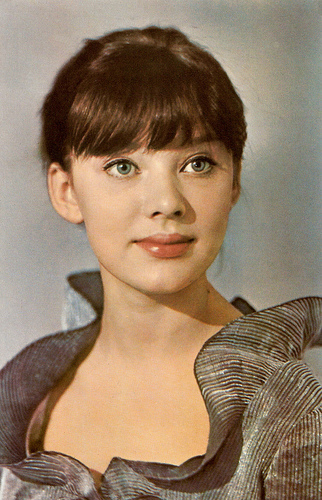
Russian postcard by Izdanije Byuro Propogandy Sovietskogo Kinoiskusstva, no. A 11239, 1966. Photo: G. Vajlja. (This postcard was printed in an edition of 100.000 cards. The price was 8 kop.)
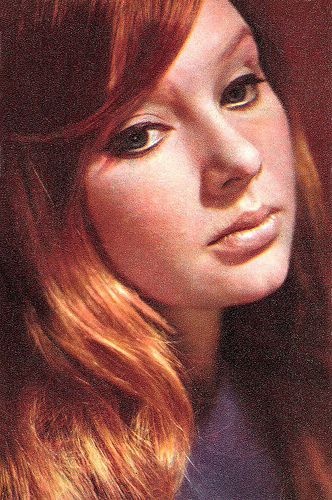
Russian postcard by Izdanije Byuro Propogandy Sovietskogo Kinoiskusstva, no. 2979, 1975. Photo: Don. (This postcard was printed in an edition of 600.000 cards. The price was 5 kop.)
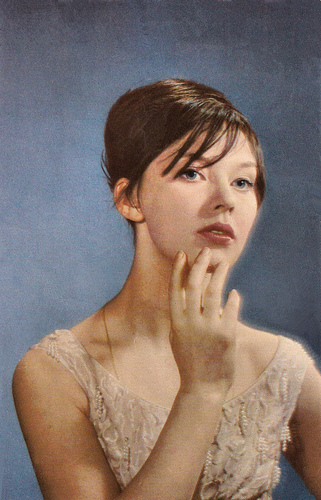
Russian postcard by Izdanije Byuro Propogandy Sovietskogo Kinoiskusstva, no. A 03286, 1969. This postcard was printed in an edition of 200,000 cards. Retail price was 8 kop.
The Most Expensive Film Ever
Lyudmila Mikhailovna Savelyeva was born in Leningrad, Soviet Union (now St. Petersburg, Russia), in 1942.
She studied ballet at the Ballet Academy of Leningrad and worked for the Leningrad Opera and Ballet Theater, now the Mariinski Theater. In 1964 the ballet Sleeping Beauty in which she performed was adapted to film.
Spyashchaya krasavitsa/Sleeping Beauty (Apollinari Dudko, Konstantin Sergeyev, 1964) was seen by director Sergei Bondarchuk , who invited her for the leading part in his next film, Voyna i mir/War and Peace (1965-1967).
The inexperienced Savelyeva played Natasha Rostova opposite the director himself as Pierre Bezukhov. The 7-hour-long film epic won the 1968 Academy Award for Best Foreign Language Film, and brought Bondarchuk a reputation of one of the finest directors of his generation.
Recognized as the most expensive project in film history, Voyna i mir was produced over seven years, at an estimated cost of $100,000,000 (over $700,000,000 adjusted for inflation in 2008).
The film set several records, such as involving tens of thousands of actors and extras from the Red Army in filming of the 3rd two-hour-long episode about the historic Battle of Borodino against Napoleon's invasion, making it the largest battle scene ever filmed.
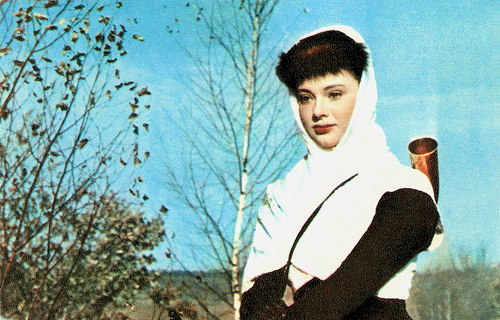
Russian postcard by Izdanije Byuro Propogandy Sovietskogo Kinoiskusstva, no. A 08339, 1969. This postcard was printed in an edition of 500,000 cards. Retail price was 6 kop. Photo: publicity still for Voyna i mir/War and Peace (Sergei Bondarchuk, 1965-1967).
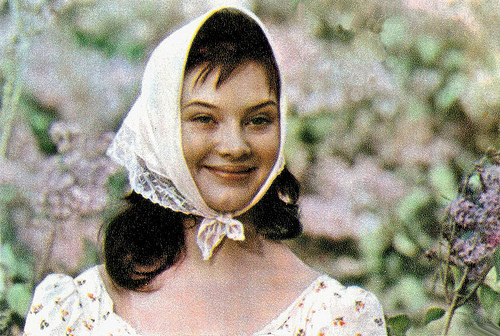
Russian postcard by Izdanije Byuro Propogandy Sovietskogo Kinoiskusstva, no. A 08343, 1969. This postcard was printed in an edition of 500,000 cards. Retail price was 6 kop. Photo: publicity still for Voyna i mir/War and Peace (Sergei Bondarchuk, 1965-1967).

Russian postcard by Izdanije Byuro Propogandy Sovietskogo Kinoiskusstva, no. A 08351, 1969. This postcard was printed in an edition of 500,000 cards. Retail price was 6 kop. Photo: publicity still for Voyna i mir/War and Peace (Sergei Bondarchuk, 1965-1967).
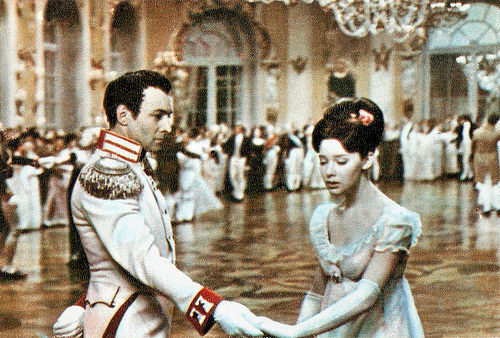
Russian postcard by Izdanije Byuro Propogandy Sovietskogo Kinoiskusstva, no. A 08356, 1969. This postcard was printed in an edition of 500,000 cards. Retail price was 6 kop. Photo: publicity still for Voyna i mir/War and Peace (Sergei Bondarchuk, 1965-1967).
Sunflower
In her next film, Chayka/The Seagull (Yuli Karasik, 1970) Lyudmila Savelyeva proved to be one of the best actresses at interpreting Anton Chekhov's work.
According to reviewer James Brandon at IMDb she "squeezes out more pathos and passion than many actresses encounter in a lifetime. The payoff is near the end of the film; with her character Nina returning to visit her former lover after a two-year absence. Even without the context of the rest of the story, this is an arresting scene, as the actress in her late 20's [actually she was only 23 or 24 at the time, Bob] reads as though she has seen as much suffering as Mother Russia itself has experienced throughout her long history. Within the context of the story, Savelyeva's change is so magically and maddeningly profound that it should bring tears to the eye of even the most jaded film-goer.”
Another triumph soon followed with Beg/The Flight (Aleksandr Alov, Vladimir Naumov, 1970), an adaptation of the play by Mikhail Bulgakov, about the defeat of the White Army in the Russian Civil War of 1918-1921, that caused massive emigration of the upper classes and nobility.
Next she appeared opposite Sophia Loren and Marcello Mastroianni in the Oscar nominated drama I Girasoli/Sunflower (Vittorio de Sica, 1970). This Carlo Ponti production was the first Italian feature film shot in Moscow.
Very popular in the USSR was the Western Vsadnik Bez Golovy/The Headless Horseman (Vladimir Vajnshtok, 1973). This Western, based on a novel by Mayne Reid (a 19th-century writer whose works were much read in the Eastern Europe), was filmed in Cuba by a Soviet crew and includes many Cubans in the cast.
Savelyeva played the love interest, and her presence was partly responsible for the popularity of the film, according to Clarke Fountain at AllMovie.
In the following decades Lyudmila Savelyeva went on to star in several Russian films, but to less acclaim.
Recently she played supporting parts in films by director Sergei Solovyov, including Nezhnyy vozrast/The Gentle Age (2000) and the TV mini-series Anna Karenina (2009), based - once more - on a famous novel by Leo Tolstoy.
Lyudmila Savelyeva is married to actor Aleksandr Zbruyev, and they have one child.
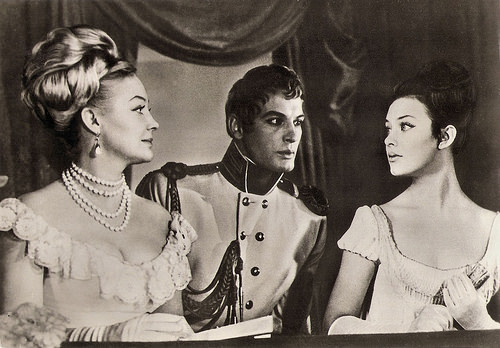
East-German postcard by VEB Progress Filmvertrieb, Berlin no. 2744, 1966. Retail price was 0,20 MDN. Photo: publicity still for Voyna i mir/War and Peace (Sergei Bondarchuk, 1965-1967) with Irina Skobzeva and Vasili Lanovoiy.
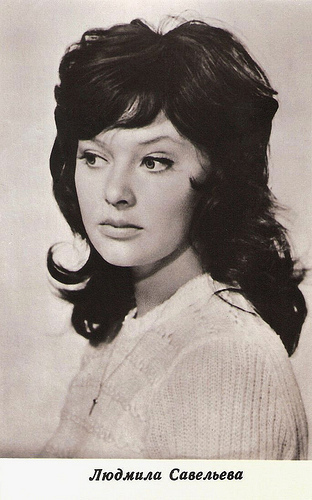
Russian postcard by Izdanije Byuro Propogandy Sovietskogo Kinoiskusstva, no. 1309, 1974. (This postcard was printed in an edition of 20.000 cards. The price was 8 kop.)
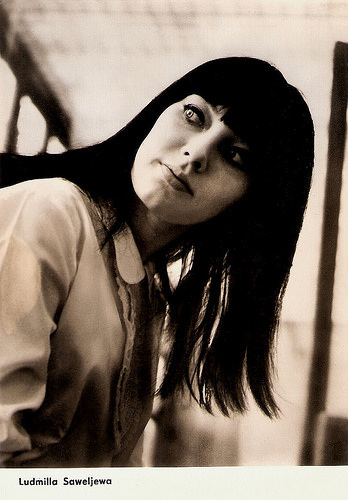
East-German postcard by VEB Progress Filmvertrieb, Berlin, no. 2832, 1967. Photo: Balinski.
Scene from I Girasoli/Sunflower (1970). Source: dvdespecial (YouTube).
Sources: (IMDb), James Brandon (IMDb), Clarke Fountain (AllMovie), Wikipedia and .

Russian postcard by Izdanije Byuro Propogandy Sovietskogo Kinoiskusstva, no. A 11239, 1966. Photo: G. Vajlja. (This postcard was printed in an edition of 100.000 cards. The price was 8 kop.)

Russian postcard by Izdanije Byuro Propogandy Sovietskogo Kinoiskusstva, no. 2979, 1975. Photo: Don. (This postcard was printed in an edition of 600.000 cards. The price was 5 kop.)

Russian postcard by Izdanije Byuro Propogandy Sovietskogo Kinoiskusstva, no. A 03286, 1969. This postcard was printed in an edition of 200,000 cards. Retail price was 8 kop.
The Most Expensive Film Ever
Lyudmila Mikhailovna Savelyeva was born in Leningrad, Soviet Union (now St. Petersburg, Russia), in 1942.
She studied ballet at the Ballet Academy of Leningrad and worked for the Leningrad Opera and Ballet Theater, now the Mariinski Theater. In 1964 the ballet Sleeping Beauty in which she performed was adapted to film.
Spyashchaya krasavitsa/Sleeping Beauty (Apollinari Dudko, Konstantin Sergeyev, 1964) was seen by director Sergei Bondarchuk , who invited her for the leading part in his next film, Voyna i mir/War and Peace (1965-1967).
The inexperienced Savelyeva played Natasha Rostova opposite the director himself as Pierre Bezukhov. The 7-hour-long film epic won the 1968 Academy Award for Best Foreign Language Film, and brought Bondarchuk a reputation of one of the finest directors of his generation.
Recognized as the most expensive project in film history, Voyna i mir was produced over seven years, at an estimated cost of $100,000,000 (over $700,000,000 adjusted for inflation in 2008).
The film set several records, such as involving tens of thousands of actors and extras from the Red Army in filming of the 3rd two-hour-long episode about the historic Battle of Borodino against Napoleon's invasion, making it the largest battle scene ever filmed.

Russian postcard by Izdanije Byuro Propogandy Sovietskogo Kinoiskusstva, no. A 08339, 1969. This postcard was printed in an edition of 500,000 cards. Retail price was 6 kop. Photo: publicity still for Voyna i mir/War and Peace (Sergei Bondarchuk, 1965-1967).

Russian postcard by Izdanije Byuro Propogandy Sovietskogo Kinoiskusstva, no. A 08343, 1969. This postcard was printed in an edition of 500,000 cards. Retail price was 6 kop. Photo: publicity still for Voyna i mir/War and Peace (Sergei Bondarchuk, 1965-1967).

Russian postcard by Izdanije Byuro Propogandy Sovietskogo Kinoiskusstva, no. A 08351, 1969. This postcard was printed in an edition of 500,000 cards. Retail price was 6 kop. Photo: publicity still for Voyna i mir/War and Peace (Sergei Bondarchuk, 1965-1967).

Russian postcard by Izdanije Byuro Propogandy Sovietskogo Kinoiskusstva, no. A 08356, 1969. This postcard was printed in an edition of 500,000 cards. Retail price was 6 kop. Photo: publicity still for Voyna i mir/War and Peace (Sergei Bondarchuk, 1965-1967).
Sunflower
In her next film, Chayka/The Seagull (Yuli Karasik, 1970) Lyudmila Savelyeva proved to be one of the best actresses at interpreting Anton Chekhov's work.
According to reviewer James Brandon at IMDb she "squeezes out more pathos and passion than many actresses encounter in a lifetime. The payoff is near the end of the film; with her character Nina returning to visit her former lover after a two-year absence. Even without the context of the rest of the story, this is an arresting scene, as the actress in her late 20's [actually she was only 23 or 24 at the time, Bob] reads as though she has seen as much suffering as Mother Russia itself has experienced throughout her long history. Within the context of the story, Savelyeva's change is so magically and maddeningly profound that it should bring tears to the eye of even the most jaded film-goer.”
Another triumph soon followed with Beg/The Flight (Aleksandr Alov, Vladimir Naumov, 1970), an adaptation of the play by Mikhail Bulgakov, about the defeat of the White Army in the Russian Civil War of 1918-1921, that caused massive emigration of the upper classes and nobility.
Next she appeared opposite Sophia Loren and Marcello Mastroianni in the Oscar nominated drama I Girasoli/Sunflower (Vittorio de Sica, 1970). This Carlo Ponti production was the first Italian feature film shot in Moscow.
Very popular in the USSR was the Western Vsadnik Bez Golovy/The Headless Horseman (Vladimir Vajnshtok, 1973). This Western, based on a novel by Mayne Reid (a 19th-century writer whose works were much read in the Eastern Europe), was filmed in Cuba by a Soviet crew and includes many Cubans in the cast.
Savelyeva played the love interest, and her presence was partly responsible for the popularity of the film, according to Clarke Fountain at AllMovie.
In the following decades Lyudmila Savelyeva went on to star in several Russian films, but to less acclaim.
Recently she played supporting parts in films by director Sergei Solovyov, including Nezhnyy vozrast/The Gentle Age (2000) and the TV mini-series Anna Karenina (2009), based - once more - on a famous novel by Leo Tolstoy.
Lyudmila Savelyeva is married to actor Aleksandr Zbruyev, and they have one child.

East-German postcard by VEB Progress Filmvertrieb, Berlin no. 2744, 1966. Retail price was 0,20 MDN. Photo: publicity still for Voyna i mir/War and Peace (Sergei Bondarchuk, 1965-1967) with Irina Skobzeva and Vasili Lanovoiy.

Russian postcard by Izdanije Byuro Propogandy Sovietskogo Kinoiskusstva, no. 1309, 1974. (This postcard was printed in an edition of 20.000 cards. The price was 8 kop.)

East-German postcard by VEB Progress Filmvertrieb, Berlin, no. 2832, 1967. Photo: Balinski.
Scene from I Girasoli/Sunflower (1970). Source: dvdespecial (YouTube).
Sources: (IMDb), James Brandon (IMDb), Clarke Fountain (AllMovie), Wikipedia and .
Published on August 05, 2014 23:00
August 4, 2014
Maria Solveg
German film and screenwriter Maria Solveg or Maria Matray (1907–1993) was a star of the late Weimar cinema. When Hitler came to power, the Jewish actress went in exile and had a new career in the US as a choreographer and writer.
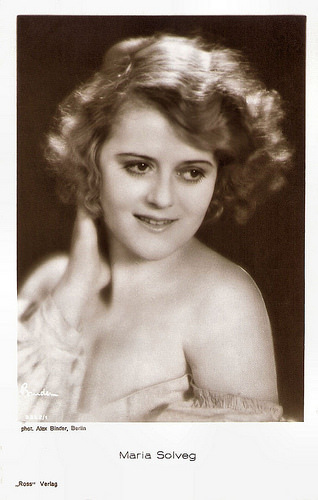
German postcard by Ross Verlag, no. 3362/1, 1928-1929. Photo: Alex Binder, Berlin.
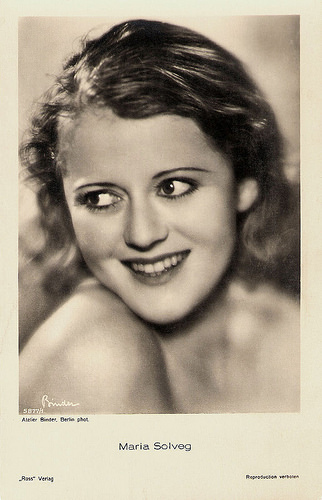
German postcard by Ross Verlag, no. 5877/1, 1930-1931. Photo: Atelier Binder, Berlin.
The typical modern girl
Maria Solveg was born as Maria Stern in Niederschönhausen German Empire (now a part of Berlin, Germany), in 1907. Her aunt was German artist Käthe Kollwitz. Two of her older sisters were the actresses Johanna Hofer and Regula Keller, and the third was the dancer Katta Sterna.
Maria studied ballet as a child. At age 14, she left school and joined actor-director Ernst Matray's theatrical tour.
She began appearing in German films at 16. She made her film debut as Maria Solveg in the Austrian silent film Der letzte Deutschmeister/The Last German master (Johann Leopold Pock, 1923).
As the typical modern girl, Maria soon became a star of late Weimar cinema. She co-starred with Ernst Matray in Die wunderlichen Geschichten des Theodor Huber/The whimsical stories of Theodore Huber (Richard Löwenbein, 1924).
In 1927 she played the female lead in the silent historical comedy Der Meister von Nürnberg/The Master of Nuremberg (Ludwig Berger, 1927) starring Rudolf Rittner, Max Gülstorff and Gustav Fröhlich . The film is based on the opera Die Meistersinger von Nürnberg (1868) by Richard Wagner. According to Wikipedia, it was considered artistically unsuccessful because of its overly theatrical presentation.
While touring America in 1927, she married Matray. She developed into a fine choreographer and worked with Austrian theatre director Max Reinhardt. As a film actress she continued to be credited as Maria Solveg and smoothly made the transition to sound film.
In the mystery romance Der Sohn des weißen Berges/The Son of the White Mountain (Mario Bonnard, Luis Trenker , 1930) she co-starred with Trenker and Renate Müller . The film was part of the popular series of Mountain films of the era.
It was followed by the musical Ich glaub nie mehr an eine Frau/Never Trust a Woman (Max Reichmann, 1930) starring Richard Tauber , Paul Hörbiger and Werner Fuetterer , and the historical biopic Elisabeth von Österreich/Elisabeth of Austria (Adolf Trotz, 1931) featuring Lil Dagover as Empress Elisabeth of Austria.
Later films included the crime film Der Weg nach Rio/Road to Rio (Manfred Noa, 1931) also with Oskar Homolka and Oskar Marion , and the Harry Piel vehicle Der Geheimagent/The Secret Agent (Harry Piel, 1932).
A success was Der Hexer/The Sorceror (Martin Frič, Karel Lamač, 1932) a screen adaptation of Edgar Wallace's thriller The Ringer. She played the female lead opposite Paul Richter and Fritz Rasp .
Sadly, she then appeared in only one more film, Ein Mann mit Herz/A man with heart (Géza von Bolváry, 1932) opposite Gustav Fröhlich .
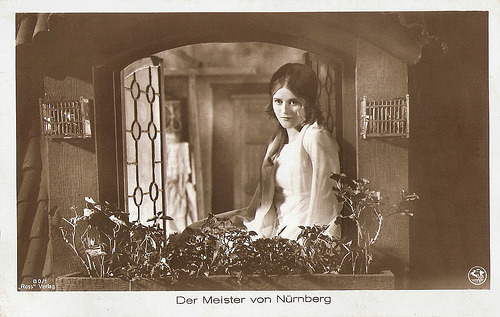
German postcard by Ross Verlag, no. 80/1. Photo: Phoebus-Film, Berlin. Publicity still for Der Meister von Nürnberg/The Master of Nuremberg (Ludwig Berger, 1927).
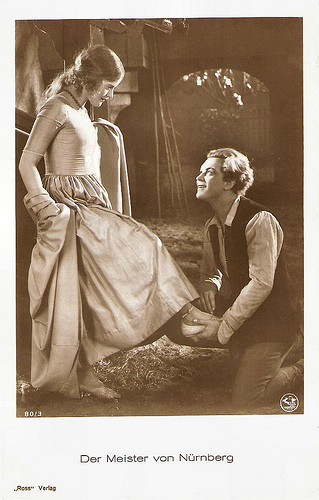
German postcard by Ross Verlag, no. 80/3. Photo: Phoebus-Film, Berlin. Publicity still for Der Meister von Nürnberg/The Master of Nuremberg (Ludwig Berger, 1927) with Gustav Fröhlich . Collection: Egbert Barten.
In exile
Following the Nazi takeover in 1933, the Jewish Maria Matray went into exile with her husband – initially in France and Britain before moving on the United States.
She couldn’t find jobs as an actress, but in 1938 she became the assistant of Max Reinhardt for the stage production of Faust in Los Angeles and San Francisco.
In Hollywood, she developed a new career as a choreographer and writer, as Maria Matray. Together with her husband, she choreographed several Hollywood movies, often without a screen credit, most notably White Cargo (Richard Thorpe, 1942), Swing Fever (Tim Whelan, 1943), and The Private Affairs of Bel Ami (Albert Lewin, 1947).
One of her stories as adapted for the musical mystery Murder in the Music Hall (John English, 1946) starring Vera Ralston. It involves a murder in Radio City Music Hall with The Rockettes as suspects.
She also wrote the screenplay for the TV film The Last Act (William Asher, 1952), an episode of Invitation Playhouse: Mind Over Murder.
The Matrays moved back to Germany in 1953. For television, she wrote screenplays for Der König mit dem Regenschirm/The king with the umbrella (Ernst Matray, 1954), and Abschiedsvorstellung/Farewell performance (Ernst Matray, 1955), with Elfie Mayerhofer .
She and Ernest Matray then separated and they officially divorced in 1962. Maria began writing novels and scripts for television with her new partner, Answald Krüger.
They also worked for the cinema and wrote screenplays for Mein Vater, der Schauspieler/My father, the actor (Robert Siodmak 1956) featuring O.W. Fischer , Wie ein Sturmwind/Tempestuous Love (Falk Harnack, 1957) starring Lilli Palmer , and the musical ...und abends in die Scala/An evening at the Scala (Erik Ode, 1958) with Caterina Valente .
The best known of these films is probably Die schöne Lügnerin/The beautiful liar (Axel von Ambesser, 1959) starring Romy Schneider and Jean-Claude Pascal .
She continued writing scripts with Krüger until his death in 1977. One of their later scripts was for Maximilian von Mexiko/Maximilan of Mexico (Günter Gräwert, 1970), a German-Austrian historical television miniseries depicting the events of the French Intervention in Mexico which placed Emperor Maximilian on the throne of Mexico.
Later, she worked with different authors. Maria Matray continued to write TV screenplays till her death in 1993 in Munich, Germany. She was 86.
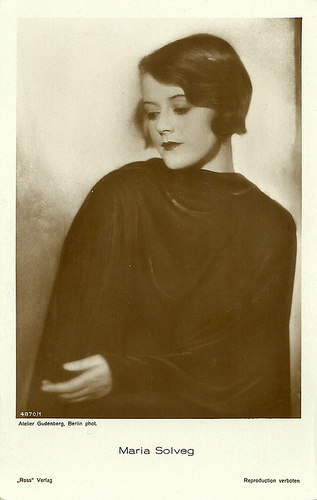
German postcard by Ross Verlag, no. 4870/1, 1929-1930. Photo: Atelier Gudenberg, Berlin.
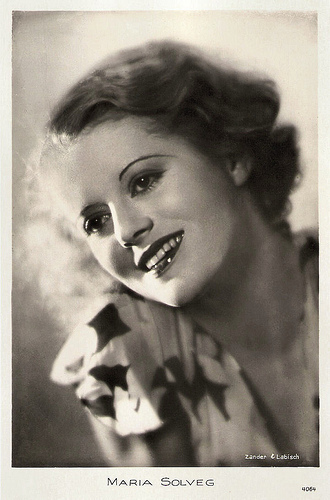
German postcard, no. 4064. Photo: Zander & Labisch.
Sources: C. Parker (Starlet Showcase), Film-Zeit.de (German), Wikipedia (German and English) and .

German postcard by Ross Verlag, no. 3362/1, 1928-1929. Photo: Alex Binder, Berlin.

German postcard by Ross Verlag, no. 5877/1, 1930-1931. Photo: Atelier Binder, Berlin.
The typical modern girl
Maria Solveg was born as Maria Stern in Niederschönhausen German Empire (now a part of Berlin, Germany), in 1907. Her aunt was German artist Käthe Kollwitz. Two of her older sisters were the actresses Johanna Hofer and Regula Keller, and the third was the dancer Katta Sterna.
Maria studied ballet as a child. At age 14, she left school and joined actor-director Ernst Matray's theatrical tour.
She began appearing in German films at 16. She made her film debut as Maria Solveg in the Austrian silent film Der letzte Deutschmeister/The Last German master (Johann Leopold Pock, 1923).
As the typical modern girl, Maria soon became a star of late Weimar cinema. She co-starred with Ernst Matray in Die wunderlichen Geschichten des Theodor Huber/The whimsical stories of Theodore Huber (Richard Löwenbein, 1924).
In 1927 she played the female lead in the silent historical comedy Der Meister von Nürnberg/The Master of Nuremberg (Ludwig Berger, 1927) starring Rudolf Rittner, Max Gülstorff and Gustav Fröhlich . The film is based on the opera Die Meistersinger von Nürnberg (1868) by Richard Wagner. According to Wikipedia, it was considered artistically unsuccessful because of its overly theatrical presentation.
While touring America in 1927, she married Matray. She developed into a fine choreographer and worked with Austrian theatre director Max Reinhardt. As a film actress she continued to be credited as Maria Solveg and smoothly made the transition to sound film.
In the mystery romance Der Sohn des weißen Berges/The Son of the White Mountain (Mario Bonnard, Luis Trenker , 1930) she co-starred with Trenker and Renate Müller . The film was part of the popular series of Mountain films of the era.
It was followed by the musical Ich glaub nie mehr an eine Frau/Never Trust a Woman (Max Reichmann, 1930) starring Richard Tauber , Paul Hörbiger and Werner Fuetterer , and the historical biopic Elisabeth von Österreich/Elisabeth of Austria (Adolf Trotz, 1931) featuring Lil Dagover as Empress Elisabeth of Austria.
Later films included the crime film Der Weg nach Rio/Road to Rio (Manfred Noa, 1931) also with Oskar Homolka and Oskar Marion , and the Harry Piel vehicle Der Geheimagent/The Secret Agent (Harry Piel, 1932).
A success was Der Hexer/The Sorceror (Martin Frič, Karel Lamač, 1932) a screen adaptation of Edgar Wallace's thriller The Ringer. She played the female lead opposite Paul Richter and Fritz Rasp .
Sadly, she then appeared in only one more film, Ein Mann mit Herz/A man with heart (Géza von Bolváry, 1932) opposite Gustav Fröhlich .

German postcard by Ross Verlag, no. 80/1. Photo: Phoebus-Film, Berlin. Publicity still for Der Meister von Nürnberg/The Master of Nuremberg (Ludwig Berger, 1927).

German postcard by Ross Verlag, no. 80/3. Photo: Phoebus-Film, Berlin. Publicity still for Der Meister von Nürnberg/The Master of Nuremberg (Ludwig Berger, 1927) with Gustav Fröhlich . Collection: Egbert Barten.
In exile
Following the Nazi takeover in 1933, the Jewish Maria Matray went into exile with her husband – initially in France and Britain before moving on the United States.
She couldn’t find jobs as an actress, but in 1938 she became the assistant of Max Reinhardt for the stage production of Faust in Los Angeles and San Francisco.
In Hollywood, she developed a new career as a choreographer and writer, as Maria Matray. Together with her husband, she choreographed several Hollywood movies, often without a screen credit, most notably White Cargo (Richard Thorpe, 1942), Swing Fever (Tim Whelan, 1943), and The Private Affairs of Bel Ami (Albert Lewin, 1947).
One of her stories as adapted for the musical mystery Murder in the Music Hall (John English, 1946) starring Vera Ralston. It involves a murder in Radio City Music Hall with The Rockettes as suspects.
She also wrote the screenplay for the TV film The Last Act (William Asher, 1952), an episode of Invitation Playhouse: Mind Over Murder.
The Matrays moved back to Germany in 1953. For television, she wrote screenplays for Der König mit dem Regenschirm/The king with the umbrella (Ernst Matray, 1954), and Abschiedsvorstellung/Farewell performance (Ernst Matray, 1955), with Elfie Mayerhofer .
She and Ernest Matray then separated and they officially divorced in 1962. Maria began writing novels and scripts for television with her new partner, Answald Krüger.
They also worked for the cinema and wrote screenplays for Mein Vater, der Schauspieler/My father, the actor (Robert Siodmak 1956) featuring O.W. Fischer , Wie ein Sturmwind/Tempestuous Love (Falk Harnack, 1957) starring Lilli Palmer , and the musical ...und abends in die Scala/An evening at the Scala (Erik Ode, 1958) with Caterina Valente .
The best known of these films is probably Die schöne Lügnerin/The beautiful liar (Axel von Ambesser, 1959) starring Romy Schneider and Jean-Claude Pascal .
She continued writing scripts with Krüger until his death in 1977. One of their later scripts was for Maximilian von Mexiko/Maximilan of Mexico (Günter Gräwert, 1970), a German-Austrian historical television miniseries depicting the events of the French Intervention in Mexico which placed Emperor Maximilian on the throne of Mexico.
Later, she worked with different authors. Maria Matray continued to write TV screenplays till her death in 1993 in Munich, Germany. She was 86.

German postcard by Ross Verlag, no. 4870/1, 1929-1930. Photo: Atelier Gudenberg, Berlin.

German postcard, no. 4064. Photo: Zander & Labisch.
Sources: C. Parker (Starlet Showcase), Film-Zeit.de (German), Wikipedia (German and English) and .
Published on August 04, 2014 23:00
Paul van Yperen's Blog
- Paul van Yperen's profile
- 13 followers
Paul van Yperen isn't a Goodreads Author
(yet),
but they
do have a blog,
so here are some recent posts imported from
their feed.



